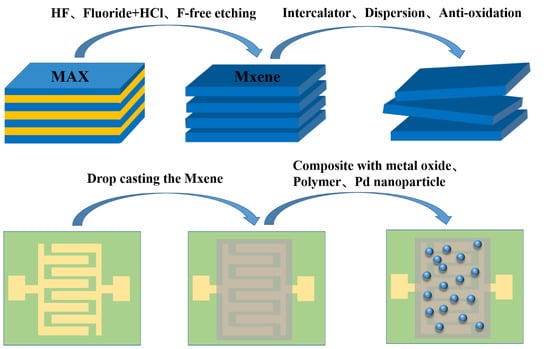Preparation and Application of 2D MXene-Based Gas Sensors: A Review
Abstract
:1. Introduction
2. Synthesis of MXene
2.1. Etching
2.2. Intercalator
2.3. Dispersion
2.4. Large-Scale Synthesis
3. MXene-Based Gas Sensors
3.1. Pristine MXene
3.2. MXene/Metal Oxide Gas Sensors
3.3. MXene/Polymer Gas Sensors
3.4. Pd-MXene Gas Sensor
3.5. Miscellaneous Sensors
4. Sensing Mechanism of MXene-Based Gas Sensors
5. Conclusions and Outlook
Author Contributions
Funding
Institutional Review Board Statement
Informed Consent Statement
Data Availability Statement
Conflicts of Interest
References
- Hao, M.; Zeng, W.; Li, Y.-Q.; Wang, Z.-C. Three-dimensional graphene and its composite for gas sensors. Rare Met. 2021, 40, 1494–1514. [Google Scholar] [CrossRef]
- Wang, C.; Wang, Y.; Yang, Z.; Hu, N. Review of recent progress on graphene-based composite gas sensors. Ceram. Int. 2021, 47, 16367–16384. [Google Scholar] [CrossRef]
- Bai, S.; Han, J.; Meng, J.C.; Sun, L.; Sun, J.; Zhao, Y.; Tang, P.; Luo, R.; Li, D.; Chen, A. NiO/ZnO composite decorated on rGO for detection of NO2. Sens. Actuators B Chem. 2021, 339, 129720. [Google Scholar] [CrossRef]
- Yao, X.; Zhao, J.; Jin, Z.; Jiang, Z.; Xu, D.; Wang, F.; Zhang, X.; Song, H.; Pan, D.; Chen, Y.; et al. Flower-like hydroxyfluoride-sensing platform toward NO2 detection. ACS Appl. Mater. Interfaces 2021, 13, 26278–26287. [Google Scholar] [CrossRef]
- Raj, I.L.P.; Gobalakrishnan, S.; Praseetha, P.K.; Chidhambaram, N.; Saravanakumar, S.; Ganesh, V.; AlFaify, S.; Algarni, H.; Yahia, I.S. Improved ammonia vapor sensing properties of Al-doped ZnO nanoparticles prepared by sol-gel process. Phys. Scr. 2021, 96, 085802. [Google Scholar] [CrossRef]
- Hien, H.T.; Ngan, P.Q.; Thai, G.H.; Trung, T.; Tan, M.M.; Giang, H.T. High NH3 sensing performance of NiO/PPy hybrid nanostructures. Sens. Actuators B Chem. 2021, 340, 129986. [Google Scholar] [CrossRef]
- Maheswari, S.; Karunakaran, M.; Hariprasad, K.; Kasirajan, K.; Raj, I.L.P.; Chandrasekar, L.B.; Alshahrani, T.; Shkir, M.; Aifaify, S. Noticeable enhancement in NH3 sensing performance of nebulizer spray pyrolysis deposited SnO2 thin films: An effect of Tb doping. Superlattices Microstruct. 2021, 154, 106868. [Google Scholar] [CrossRef]
- Chang, J.; Deng, Z.; Fang, X.; Hu, C.; Shi, L.; Dai, T.; Li, M.; Wang, S.; Meng, G. Heterostructural (Sr0.6Bi0.305)(2)Bi2O7/ZnO for novel high-performance H2S sensor operating at low temperature. J. Hazard. Mater. 2021, 414, 125500. [Google Scholar] [CrossRef] [PubMed]
- Wang, H.; Luo, Y.; Liu, B.; Gao, L.; Duan, G. CuO nanoparticle loaded ZnO hierarchical heterostructure to boost H2S sensing with fast recovery. Sens. Actuators B Chem. 2021, 338, 129806. [Google Scholar] [CrossRef]
- Luo, Y.; An, B.; Bai, J.; Wang, Y.; Cheng, X.; Wang, Q.; Li, J.; Yang, Y.; Wu, Z.; Xie, E. Ultrahigh-response hydrogen sensor based on PdO/NiO co-doped In2O3 nanotubes. J. Colloid Interface Sci. 2021, 599, 533–542. [Google Scholar] [CrossRef]
- Kasapoglu, A.E.; Habashyani, S.; Baltakesmez, A.; Iskenderoglu, D.; Gur, E. The effect of the change in the amount of Sb doping in ZnO nanorods for hydrogen gas sensors. Int. J. Hydrogen Energy 2021, 46, 21715–21725. [Google Scholar] [CrossRef]
- Hu, K.; Wang, F.; Shen, Z.; Yan, Y.; Liu, H. Enhancement methods of hydrogen sensing for one-dimensional nanomaterials: A review. Int. J. Hydrogen Energy 2021, 46, 20119–20138. [Google Scholar] [CrossRef]
- Gonzalez-Garnica, M.; Galdamez-Martinez, A.; Malagon, F.; Ramos, C.D.; Santana, G.; Abolhassani, R.; Panda, P.K.; Kaushik, A.; Mishra, Y.K.; Karthik, T.V.K.; et al. One dimensional Au-ZnO hybrid nanostructures based CO2 detection: Growth mechanism and role of the seed layer on sensing performance. Sens. Actuators B Chem. 2021, 337, 129765. [Google Scholar] [CrossRef]
- Van Tong, P.; Minh, L.H.; Van Duy, N.; Hung, C.M. Porous In2O3 nanorods fabricated by hydrothermal method for an effective CO gas sensor. Mater. Res. Bull. 2021, 137, 111179. [Google Scholar] [CrossRef]
- Hung, N.M.; Hung, C.M.; Van Duy, N.; Hoa, N.D.; Hong, H.S.; Dang, T.K.; Viet, N.N.; Thong, L.T.; Phuoc, P.H.; Van Hieu, N. Significantly enhanced NO2 gas-sensing performance of nanojunction-networked SnO2 nanowires by pulsed UV-radiation. Sens. Actuators A Phys. 2021, 327, 112759. [Google Scholar] [CrossRef]
- Pi, M.; Zheng, L.; Luo, H.; Duan, S.; Li, C.; Yang, J.; Zhang, D.; Chen, S. Improved acetone gas sensing performance based on optimization of a transition metal doped WO3 system at room temperature. J. Phys. D Appl. Phys. 2021, 54, 155107. [Google Scholar] [CrossRef]
- Harathi, N.; Sarkar, A. TiO2 based surface acoustic wave gas sensor with modified electrode dimensions for enhanced H2 sensing application. Int. J. Nano Dimens. 2021, 12, 83–89. [Google Scholar]
- Yang, J.; Han, W.; Ma, J.; Wang, C.; Shimanoe, K.; Zhang, S.; Sun, Y.; Cheng, P.; Wang, Y.; Zhang, H.; et al. Sn doping effect on NiO hollow nanofibers based gas sensors about the humidity dependence for triethylamine detection. Sens. Actuators B Chem. 2021, 340, 129971. [Google Scholar] [CrossRef]
- Bai, H.; Guo, H.; Wang, J.; Dong, Y.; Liu, B.; Xie, Z.; Guo, F.; Chen, D.; Zhang, R.; Zheng, Y. A room-temperature NO2 gas sensor based on CuO nanoflakes modified with rGO nanosheets. Sens. Actuators B Chem. 2021, 337, 129783. [Google Scholar] [CrossRef]
- Umar, A.; Ibrahim, A.A.; Kumar, R.; Albargi, H.; Zeng, W.; Alhmami, M.A.M.; Alsaiari, M.A.; Baskoutas, S. Gas sensor device for high-performance ethanol sensing using alpha-MnO2 nanoparticles. Mater. Lett. 2021, 286, 129232. [Google Scholar] [CrossRef]
- Xu, T.-T.; Zhang, X.-F.; Dong, X.; Deng, Z.-P.; Huo, L.-H.; Gao, S. Enhanced H2S gas-sensing performance of Zn2SnO4 hierarchical quasi-microspheres constructed from nanosheets and octahedra. J. Hazard. Mater. 2019, 361, 49–55. [Google Scholar] [CrossRef] [PubMed]
- Subramanian, M.; Dhayabaran, V.V.; Shanmugavadivel, M. Fiber optic gas sensing properties of Ni2V2O7 nanorods operable at room temperature. Mater. Sci. Eng. B 2020, 259, 114604. [Google Scholar] [CrossRef]
- Wang, B.; Yu, Q.; Zhang, S.; Wang, T.; Sun, P.; Chuai, X.; Lu, G. Gas sensing with yolk-shell LaFeO3 microspheres prepared by facile hydrothermal synthesis. Sens. Actuators B Chem. 2018, 258, 1215–1222. [Google Scholar] [CrossRef]
- Yao, D.; Dong, C.; Bing, Q.; Liu, Y.; Qu, F.; Yang, M.; Liu, B.; Yang, B.; Zhang, H. Oxygen-defective ultrathin BiVO4 nanosheets for enhanced gas sensing. ACS Appl. Mater. Interfaces 2019, 11, 23495–23502. [Google Scholar] [CrossRef] [PubMed]
- Kim, J.K.; Han, M.; Kim, Y.; An, H.K.; Lee, S.; Kong, S.H.; Jung, D. Pd-decorated multi-walled carbon nanotube sensor for hydrogen detection. J. Nanosci. Nanotechnol. 2021, 21, 3707–3710. [Google Scholar] [CrossRef] [PubMed]
- Ridhi, R.; Neeru; Gautam, S.; Saini, G.S.S.; Tripathi, S.K.; Rawat, J.S.; Jha, P. Study of the effect of orbital on interaction behaviour of SWCNT- metal phthalocyanines composites with ammonia gas. Sens. Actuators B Chem. 2021, 337, 129767. [Google Scholar] [CrossRef]
- Jeong, D.-W.; Kim, K.H.; Kim, B.S.; Byun, Y.T. Characteristics of highly sensitive and selective nitric oxide gas sensors using defect-functionalized single-walled carbon nanotubes at room temperature. Appl. Surf. Sci. 2021, 550, 149250. [Google Scholar] [CrossRef]
- Matatagui, D.; Lopez-Sanchez, J.; Pena, A.; Serrano, A.; del Campo, A.; de la Fuente, O.R.; Carmona, N.; Navarro, E.; Marin, P.; Carmen Horrillo, M.D. Ultrasensitive NO2 gas sensor with insignificant NH3-interference based on a few-layered mesoporous graphene. Sens. Actuators B Chem. 2021, 335, 129657. [Google Scholar] [CrossRef]
- Qu, C.; Zhao, P.; Wu, C.; Zhuang, Y.; Liu, J.; Li, W.; Liu, Z.; Liu, J. Electrospun PAN/PANI fiber film with abundant active sites for ultrasensitive trimethylamine detection. Sens. Actuators B Chem. 2021, 338, 129822. [Google Scholar] [CrossRef]
- Thangamani, G.J.; Deshmukh, K.; Nambiraj, N.A.; Pasha, S.K.K. Chemiresistive gas sensors based on vanadium pentoxide reinforced polyvinyl alcohol/polypyrrole blend nanocomposites for room temperature LPG sensing. Synth. Met. 2021, 273, 116687. [Google Scholar] [CrossRef]
- Yuan, Y.; Wu, H.; Bu, X.; Wu, Q.; Wang, X.; Han, C.; Li, X.; Wang, X.; Liu, W. Improving ammonia detecting performance of polyaniline decorated rGO composite membrane with GO Doping. Materials 2021, 14, 2829. [Google Scholar] [CrossRef]
- Zhang, Z.; Du, H.; Yi, W.; Sun, Y.; Zheng, Y.; Wu, Y.; Sun, S.; Xu, S. Investigation of Ammonia-sensing mechanism on polypyrrole gas sensor based on experimental and theoretical evidence. Sens. Mater. 2021, 33, 1443–1454. [Google Scholar] [CrossRef]
- Chen, J.; Lv, H.; Bai, X.; Liu, Z.; He, L.; Wang, J.; Zhang, Y.; Sun, B.; Kan, K.; Shi, K. Synthesis of hierarchically porous Co3O4/Biomass carbon composites derived from MOFs and their highly NO2 gas sensing performance. Microporous Mesoporous Mater. 2021, 321, 111108. [Google Scholar] [CrossRef]
- Mi, Q.; Zhang, D.; Zhang, X.; Wang, D. Highly sensitive ammonia gas sensor based on metal-organic frameworks-derived CoSe2@nitrogen-doped amorphous carbon decorated with multi-walled carbon nanotubes. J. Alloys Compd. 2021, 860, 158252. [Google Scholar] [CrossRef]
- Li, X.; Zhang, Y.; Cheng, Y.; Chen, X.; Tan, W. MOF-derived porous hierarchical ZnCo2O4 microflowers for enhanced performance gas sensor. Ceram. Int. 2021, 47, 9214–9224. [Google Scholar] [CrossRef]
- Michel, C.R.; Martinez-Preciado, A.H.; Lopez Contreras, N.L. Gas sensing properties of Nd2O3 nanostructured microspheres. Sens. Actuators B Chem. 2013, 184, 8–14. [Google Scholar] [CrossRef]
- Michel, C.R.; Martinez-Preciado, A.H. CO sensing properties of novel nanostructured La2O3 microspheres. Sens. Actuators B Chem. 2015, 208, 355–362. [Google Scholar] [CrossRef]
- Bi, H.; Zhang, L.-X.; Xing, Y.; Zhang, P.; Chen, J.-J.; Yin, J.; Bie, L.-J. Morphology-controlled synthesis of CeO2 nanocrystals and their facet-dependent gas sensing properties. Sens. Actuators B Chem. 2021, 330, 129374. [Google Scholar] [CrossRef]
- Lei, G.; Lou, C.; Liu, X.; Xie, J.; Li, Z.; Zheng, W.; Zhang, J. Thin films of tungsten oxide materials for advanced gas sensors. Sens. Actuators B Chem. 2021, 341, 129996. [Google Scholar] [CrossRef]
- Wang, Y.; Zhang, S.; Huang, C.; Qu, F.; Yao, D.; Guo, H.; Xu, H.; Jiang, C.; Yang, M. Mesoporous WO3 modified by Au nanoparticles for enhanced trimethylamine gas sensing properties. Dalton Trans. 2021, 50, 970–978. [Google Scholar] [CrossRef] [PubMed]
- Chaloeipote, G.; Prathumwan, R.; Subannajui, K.; Wisitsoraat, A.; Wongchoosuk, C. 3D printed CuO semiconducting gas sensor for ammonia detection at room temperature. Mater. Sci. Semicond. Process. 2021, 123, 105546. [Google Scholar] [CrossRef]
- Ma, J.; Fan, H.; Li, Z.; Jia, Y.; Yadav, A.K.; Dong, G.; Wang, W.; Dong, W.; Wang, S. Multi-walled carbon nanotubes/polyaniline on the ethylenediamine modified polyethylene terephthalate fibers for a flexible room temperature ammonia gas sensor with high responses. Sens. Actuators B Chem. 2021, 334, 129677. [Google Scholar] [CrossRef]
- Yan, D.; Xia, S.; Li, S.; Wang, S.; Tan, M.; Liu, S. Electrophoretic deposition of multiwalled carbon nanotubes onto porous silicon with enhanced NO2-sensing characteristics. Mater. Res. Bull. 2021, 134, 111109. [Google Scholar] [CrossRef]
- Gupta, M.; Hawari, H.F.; Kumar, P.; Burhanudin, Z.A.; Tansu, N. Functionalized Reduced Graphene oxide thin films for ultrahigh CO2 gas sensing performance at room temperature. Nanomaterials 2021, 11, 623. [Google Scholar] [CrossRef]
- Adhikari, A.; Tiwary, P.; Rana, D.; Halder, A.; Nath, J.; Basu, A.; Ghoshal, D.; Kar, P.; Chakraborty, A.K.; Chattopadhyay, D. Na-cholate micelle mediated synthesis of polypyrrole nanoribbons for ethanol sensing. J. Environ. Chem. Eng. 2020, 8, 104249. [Google Scholar] [CrossRef]
- Fu, Y.; Xin, M.; Chong, J.; Li, R.; Huang, M. Plasmonic gold nanostars@ZIF-8 nanocomposite for the ultrasensitive detection of gaseous formaldehyde. J. Mater. Sci. 2021, 56, 4151–4160. [Google Scholar] [CrossRef]
- Zhan, M.; Hussain, S.; AlGarni, T.S.; Shah, S.; Liu, J.; Zhang, X.; Ahmad, A.; Javed, M.S.; Qiao, G.; Liu, G. Facet controlled polyhedral ZIF-8 MOF nanostructures for excellent NO2 gas-sensing applications. Mater. Res. Bull. 2021, 136, 111133. [Google Scholar] [CrossRef]
- Qin, Y.; Wang, X. Experiments combined with first-principles calculations to compare the enhancement of Ag-doping and -functionalization on the sensing properties of two-dimensional SnS. Phys. E Low-Dimens. Syst. Nanostruct. 2021, 131, 114752. [Google Scholar] [CrossRef]
- Hermawan, A.; Zhang, B.; Taufik, A.; Asakura, Y.; Hasegawa, T.; Zhu, J.; Shi, P.; Yin, S. CuO nanoparticles/Ti3C2Tx MXene hybrid nanocomposites for detection of toluene Gas. ACS Appl. Nano Mater. 2020, 3, 4755–4766. [Google Scholar] [CrossRef]
- Naguib, M.; Kurtoglu, M.; Presser, V.; Lu, J.; Niu, J.; Heon, M.; Hultman, L.; Gogotsi, Y.; Barsoum, M.W. Two-dimensional nanocrystals produced by exfoliation of Ti3AlC2. Adv. Mater. 2011, 23, 4248–4253. [Google Scholar] [CrossRef] [PubMed] [Green Version]
- Wu, Y.; Sun, Y.; Zheng, J.; Rong, J.; Li, H.; Niu, L. Exploring MXene-based materials for next-generation rechargeable batteries. J. Phys. Energy 2021, 3, 032009. [Google Scholar] [CrossRef]
- Qi, Z.; Wang, S.; Li, Y.; Wang, L.; Zhao, L.; Ge, Q.; Zhang, J.Z. Scavenging activity and reaction mechanism of Ti3C2Tx MXene as a novel free radical scavenger. Ceram. Int. 2021, 47, 16555–16561. [Google Scholar] [CrossRef]
- Iravani, S.; Varma, R.S. MXenes for cancer therapy and diagnosis: Recent advances and current challenges. ACS Biomater. Sci. Eng. 2021, 7, 1900–1913. [Google Scholar] [CrossRef]
- Naguib, M.; Unocic, R.R.; Armstrong, B.L.; Nanda, J. Large-scale delamination of multi-layers transition metal carbides and carbonitrides “MXenes”. Dalton Trans. 2015, 44, 9353–9358. [Google Scholar] [CrossRef]
- Naguib, M.; Mochalin, V.N.; Barsoum, M.W.; Gogotsi, Y. 25th Anniversary Article: MXenes: A new family of Two-dimensional materials. Adv. Mater. 2014, 26, 992–1005. [Google Scholar] [CrossRef]
- Zhang, M.; Wang, Y.; Gao, F.; Wang, Y.; Shen, X.; He, N.; Zhu, J.; Chen, Y.; Wan, X.; Lian, X.; et al. Formation of new MXene film using spinning coating method with DMSO solution and its application in advanced memristive device. Ceram. Int. 2019, 45, 19467–19472. [Google Scholar] [CrossRef]
- Wu, X.; Ma, P.; Sun, Y.; Du, F.; Song, D.; Xu, G. Application of MXene in electrochemical sensors: A Review. Electroanal 2021, 33, 1827–1851. [Google Scholar] [CrossRef]
- Cao, C.; Chang, Q.; Qiao, H.; Shao, R.; Guo, X.; Xiao, G.; Shi, W.; Huang, L. Determination of H plus ion diffusion in Ti3C2-rGO glucose sensor. Sens. Actuators B Chem. 2021, 340, 129943. [Google Scholar] [CrossRef]
- Wang, J.; Gong, J.; Zhang, H.; Lv, L.; Liu, Y.; Dai, Y. Construction of hexagonal nickel-cobalt oxide nanosheets on metal-organic frameworks based on MXene interlayer ion effect for hybrid supercapacitors. J. Alloys Compd. 2021, 870, 159466. [Google Scholar] [CrossRef]
- Mei, J.; Ayoko, G.A.; Hu, C.; Bell, J.M.; Sun, Z. Two-dimensional fluorine-free mesoporous Mo2C MXene via UV-induced selective etching of Mo2Ga2C for energy storage. Sustain. Mater. Technol. 2020, 25, e00156. [Google Scholar] [CrossRef]
- Ghasali, E.; Orooji, Y.; Azarniya, A.; Alizadeh, M.; Kazem-zad, M.; Ebadzadeh, T. Production of V2C MXene using a repetitive pattern of V2AlC MAX phase through microwave heating of Al-V2O5-C system. Appl. Surf. Sci. 2021, 542, 148538. [Google Scholar] [CrossRef]
- Zhang, Y.; Yu, J.; Lu, J.; Zhu, C.; Qi, D. Facile construction of 2D MXene (Ti3C2Tx) based aerogels with effective fire-resistance and electromagnetic interference shielding performance. J. Alloys Compd. 2021, 870, 159442. [Google Scholar] [CrossRef]
- Wang, H.; Li, X.; Luo, B.; Wei, K.; Zeng, G. The MXene/water nanofluids with high stability and photo-thermal conversion for direct absorption solar collectors: A comparative study. Energy 2021, 227, 120483. [Google Scholar] [CrossRef]
- Aghaei, S.M.; Aasi, A.; Panchapakesan, B. Experimental and theoretical advances in MXene-based gas sensors. ACS Omega 2021, 6, 2450–2461. [Google Scholar] [CrossRef]
- Pei, Y.; Zhang, X.; Hui, Z.; Zhou, J.; Huang, X.; Sun, G.; Huang, W. Ti3C2Tx MXene for sensing applications: Recent progress, design principles, and future perspectives. ACS Nano 2021, 15, 3996–4017. [Google Scholar] [CrossRef]
- Deshmukh, K.; Kovarik, T.; Pasha, S.K.K. State of the art recent progress in two dimensional MXenes based gas sensors and biosensors: A comprehensive review. Coord. Chem. Rev. 2020, 424, 213514. [Google Scholar] [CrossRef]
- Zhao, Q.-N.; Zhang, Y.-J.; Duan, Z.-H.; Wang, S.; Liu, C.; Jiang, Y.-D.; Tai, H.-L. A review on Ti3C2Tx-based nanomaterials: Synthesis and applications in gas and humidity sensors. Rare Met. 2021, 40, 1459–1476. [Google Scholar] [CrossRef]
- Shuck, C.E.; Sarycheva, A.; Anayee, M.; Levitt, A.; Zhu, Y.; Uzun, S.; Balitskiy, V.; Zahorodna, V.; Gogotsi, O.; Gogotsi, Y. Scalable synthesis of Ti3C2Tx MXene. Adv. Eng. Mater. 2020, 22, 1901241. [Google Scholar] [CrossRef]
- Chen, B.; Feng, A.; Liu, K.; Wu, J.; Yu, Y.; Song, L. Subsize Ti3C2Tx derived from molten-salt synthesized Ti3AlC2 for enhanced capacitive deionization. Ceram. Int. 2021, 47, 3665–3670. [Google Scholar] [CrossRef]
- Han, M.; Liu, Y.; Rakhmanov, R.; Israel, C.; Tajin, M.A.S.; Friedman, G.; Volman, V.; Hoorfar, A.; Dandekar, K.R.; Gogotsi, Y. Solution-Processed Ti3C2Tx MXene antennas for radio-frequency communication. Adv. Mater. 2021, 33, e2003225. [Google Scholar] [CrossRef] [PubMed]
- Li, Z.; Wang, L.; Sun, D.; Zhang, Y.; Liu, B.; Hu, Q.; Zhou, A. Synthesis and thermal stability of two-dimensional carbide MXene Ti3C2. Mater. Sci. Eng. B 2015, 191, 33–40. [Google Scholar] [CrossRef]
- Su, X.; Zhang, J.; Mu, H.; Zhao, J.; Wang, Z.; Zhao, Z.; Han, C.; Ye, Z. Effects of etching temperature and ball milling on the preparation and capacitance of Ti3C2 MXene. J. Alloys Compd. 2018, 752, 32–39. [Google Scholar] [CrossRef]
- Alhabeb, M.; Maleski, K.; Anasori, B.; Lelyukh, P.; Clark, L.; Sin, S.; Gogotsi, Y. Guidelines for synthesis and processing of two-dimensional titanium carbide (Ti3C2Tx MXene). Chem. Mater. 2017, 29, 7633–7644. [Google Scholar] [CrossRef]
- Li, Y.; Shao, H.; Lin, Z.; Lu, J.; Liu, L.; Duployer, B.; Persson, P.O.A.; Eklund, P.; Hultman, L.; Li, M.; et al. A general Lewis acidic etching route for preparing MXenes with enhanced electrochemical performance in non-aqueous electrolyte. Nat. Mater. 2020, 19, 894–899. [Google Scholar] [CrossRef] [Green Version]
- Kumar, S.; Kang, D.; Hong, H.; Rehman, M.A.; Lee, Y.-J.; Lee, N.; Seo, Y. Effect of Ti3C2Tx MXenes etched at elevated temperatures using concentrated acid on binder-free supercapacitors. RSC Adv. 2020, 10, 41837–41845. [Google Scholar] [CrossRef]
- Sun, J.; Kong, W.; Jin, Z.; Han, Y.; Ma, L.; Ding, X.; Niu, Y.; Xu, Y. Recent advances of MXene as promising catalysts for electrochemical nitrogen reduction reaction. Chin. Chem. Lett. 2020, 31, 953–960. [Google Scholar] [CrossRef]
- Ghidiu, M.; Lukatskaya, M.R.; Zhao, M.-Q.; Gogotsi, Y.; Barsoum, M.W. Conductive two-dimensional titanium carbide ‘clay’ with high volumetric capacitance. Nature 2014, 516, 78–81. [Google Scholar] [CrossRef] [PubMed]
- Sinha, A.; Ma, K.; Zhao, H. 2D Ti3C2Tx flakes prepared by in-situ HF etchant for simultaneous screening of carbamate pesticides. J. Colloid Interface Sci. 2021, 590, 365–374. [Google Scholar] [CrossRef]
- Gajdosova, V.; Lorencova, L.; Prochazka, M.; Omastova, M.; Micusik, M.; Prochazkova, S.; Kveton, F.; Jerigova, M.; Velic, D.; Kasak, P.; et al. Remarkable differences in the voltammetric response towards hydrogen peroxide, oxygen and Ru(NH3)(6)(3+) of electrode interfaces modified with HF or LiF-HCl etched Ti3C2Tx MXene. Microchim. Acta 2020, 187, 1–8. [Google Scholar] [CrossRef]
- Gao, L.; Li, C.; Huang, W.; Mei, S.; Lin, H.; Ou, Q.; Zhang, Y.; Guo, J.; Zhang, F.; Xu, S.; et al. MXene/Polymer membranes: Synthesis, properties, and emerging applications. Chem. Mater. 2020, 32, 1703–1747. [Google Scholar] [CrossRef]
- Kim, S.J.; Koh, H.-J.; Ren, C.E.; Kwon, O.; Maleski, K.; Cho, S.-Y.; Anasori, B.; Kim, C.-K.; Choi, Y.-K.; Kim, J.; et al. Metallic Ti3C2Tx MXene gas sensors with ultrahigh signal-to-noise ratio. ACS Nano 2018, 12, 986–993. [Google Scholar] [CrossRef] [PubMed] [Green Version]
- Akinola, O.; Chakraborty, I.; Celio, H.; Akinwande, D.; Incorvia, J.A.C. Synthesis and characterization of Cr2C MXenes. J. Mater. Res. 2021, 36, 1980–1989. [Google Scholar] [CrossRef]
- Wang, X.; Garnero, C.; Rochard, G.; Magne, D.; Morisset, S.; Hurand, S.; Chartier, P.; Rousseau, J.; Cabioc’h, T.; Coutanceau, C.; et al. A new etching environment (FeF3/HCl) for the synthesis of two-dimensional titanium carbide MXenes: A route towards selective reactivity vs. water. J. Mater. Chem. A 2017, 5, 22012–22023. [Google Scholar] [CrossRef]
- Liu, F.; Zhou, A.; Chen, J.; Jin, J.; Zhou, W.; Wang, L.; Hu, Q. Preparation of Ti3C2 and Ti2C MXenes by fluoride salts etching and methane adsorptive properties. Appl. Surf. Sci. 2017, 416, 781–789. [Google Scholar] [CrossRef]
- He, H.; Xia, Q.; Wang, B.; Wang, L.; Hu, Q.; Zhou, A. Two-dimensional vanadium carbide (V2CTx) MXene as supercapacitor electrode in seawater electrolyte. Chin. Chem. Lett. 2020, 31, 984–987. [Google Scholar] [CrossRef]
- Handoko, A.D.; Chen, H.; Lum, Y.; Zhang, Q.; Anasori, B.; Seh, Z.W. Two-dimensional titanium and molybdenum carbide MXenes as electrocatalysts for CO2 reduction. iScience 2020, 23, 101181. [Google Scholar] [CrossRef]
- Feng, A.; Yu, Y.; Jiang, F.; Wang, Y.; Mi, L.; Yu, Y.; Song, L. Fabrication and thermal stability of NH4HF2-etched Ti3C2 MXene. Ceram. Int. 2017, 43, 6322–6328. [Google Scholar] [CrossRef]
- Feng, A.; Yu, Y.; Wang, Y.; Jiang, F.; Yu, Y.; Mi, L.; Song, L. Two-dimensional MXene Ti3C2 produced by exfoliation of Ti3AlC2. Mater. Des. 2017, 114, 161–166. [Google Scholar] [CrossRef]
- Sun, Z.; Yuan, M.; Lin, L.; Yang, H.; Nan, C.; Li, H.; Sun, G.; Yang, X. Selective Lithiation-Expansion-Microexplosion synthesis of two-dimensional fluoride-free Mxene. ACS Mater. Lett. 2019, 1, 628–632. [Google Scholar] [CrossRef]
- Wang, C.; Shou, H.; Chen, S.; Wei, S.; Lin, Y.; Zhang, P.; Liu, Z.; Zhu, K.; Guo, X.; Wu, X.; et al. HCl-based hydrothermal etching strategy toward fluoride-free MXenes. Adv. Mater. 2021, 33, 2101015. [Google Scholar] [CrossRef]
- Li, T.; Yao, L.; Liu, Q.; Gu, J.; Luo, R.; Li, J.; Yan, X.; Wang, W.; Liu, P.; Chen, B.; et al. Fluorine-free synthesis of high-purity Ti3C2Tx (T=OH, O) via alkali treatment. Angew. Chem. Int. Ed. 2018, 57, 6115–6119. [Google Scholar] [CrossRef] [PubMed]
- Zhang, B.; Zhu, J.; Shi, P.; Wu, W.; Wang, F. Fluoride-free synthesis and microstructure evolution of novel two-dimensional Ti3C2(OH)(2) nanoribbons as high-performance anode materials for lithium-ion batteries. Ceram. Int. 2019, 45, 8395–8405. [Google Scholar] [CrossRef]
- Xue, N.; Li, X.; Zhang, M.; Han, L.; Liu, Y.; Tao, X. Chemical-combined ball-milling synthesis of fluorine-free porous MXene for high-performance lithium ion batteries. ACS Appl. Energy Mater. 2020, 3, 10234–10241. [Google Scholar] [CrossRef]
- Rafieerad, A.; Amiri, A.; Sequiera, G.L.; Yan, W.; Chen, Y.; Polycarpou, A.A.; Dhingra, S. Development of fluorine-free tantalum carbide MXene hybrid structure as a biocompatible material for supercapacitor electrodes. Adv. Funct. Mater. 2021, 31, 2100015. [Google Scholar] [CrossRef]
- Sun, W.; Shah, S.A.; Chen, Y.; Tan, Z.; Gao, H.; Habib, T.; Radovic, M.; Green, M.J. Electrochemical etching of Ti2AlC to Ti2CTx (MXene) in low-concentration hydrochloric acid solution. J. Mater. Chem. A 2017, 5, 21663–21668. [Google Scholar] [CrossRef]
- Yang, S.; Zhang, P.; Wang, F.; Ricciardulli, A.G.; Lohe, M.R.; Blom, P.W.M.; Feng, X. Fluoride-free synthesis of two-dimensional titanium carbide (MXene) using a binary aqueous system. Angew. Chem. Int. Ed. 2018, 57, 15491–15495. [Google Scholar] [CrossRef]
- Song, M.; Pang, S.-Y.; Guo, F.; Wong, M.-C.; Hao, J. Fluoride-free 2D niobium carbide MXenes as stable and biocompatible nanoplatforms for electrochemical biosensors with ultrahigh sensitivity. Adv. Sci. 2020, 7, 7. [Google Scholar] [CrossRef] [PubMed]
- Jawaid, A.; Hassan, A.; Neher, G.; Nepal, D.; Pachter, R.; Kennedy, W.J.; Ramakrishnan, S.; Vaia, R.A. Halogen etch of Ti3AlC2 MAX phase for MXene fabrication. ACS Nano 2021, 15, 2771–2777. [Google Scholar] [CrossRef] [PubMed]
- Shi, H.; Zhang, P.; Liu, Z.; Park, S.; Lohe, M.R.; Wu, Y.; Shaygan Nia, A.; Yang, S.; Feng, X. Ambient-stable two-dimensional titanium carbide (MXene) enabled by iodine etching. Angew. Chem. Int. Ed. 2021, 60, 8689–8693. [Google Scholar] [CrossRef] [PubMed]
- Han, F.; Luo, S.; Xie, L.; Zhu, J.; Wei, W.; Chen, X.; Liu, F.; Chen, W.; Zhao, J.; Dong, L.; et al. Boosting the yield of MXene 2D sheets via a facile hydrothermal-assisted intercalation. ACS Appl. Mater. Interfaces 2019, 11, 8443–8452. [Google Scholar] [CrossRef]
- Xiu, L.-Y.; Wang, Z.-Y.; Qiu, J.-S. General synthesis of MXene by green etching chemistry of fluoride-free Lewis acidic melts. Rare Met. 2020, 39, 1237–1238. [Google Scholar] [CrossRef]
- Wu, S.; Wang, H.; Li, L.; Guo, M.; Qi, Z.; Zhang, Q.; Zhou, Y. Intercalated MXene-based layered composites: Preparation and application. Chin. Chem. Lett. 2020, 31, 961–968. [Google Scholar] [CrossRef]
- Mashtalir, O.; Naguib, M.; Mochalin, V.N.; Dall’Agnese, Y.; Heon, M.; Barsoum, M.W.; Gogotsi, Y. Intercalation and delamination of layered carbides and carbonitrides. Nat. Commun. 2013, 4, 1716. [Google Scholar] [CrossRef] [PubMed]
- Qian, A.; Seo, J.Y.; Shi, H.; Lee, J.Y.; Chung, C.-H. Surface functional groups and electrochemical behavior in dimethyl sulfoxide-delaminated Ti3C2Tx MXene. Chemsuschem 2018, 11, 3719–3723. [Google Scholar] [CrossRef] [PubMed]
- Overbury, S.H.; Kolesnikov, A.I.; Brown, G.M.; Zhang, Z.; Nair, G.S.; Sacci, R.L.; Lotfi, R.; van Duin, A.C.T.; Naguib, M. Complexity of intercalation in MXenes: Destabilization of urea by two-dimensional titanium carbide. J. Am. Chem. Soc. 2018, 140, 10305–10314. [Google Scholar] [CrossRef]
- Xu, P.; Xiao, H.; Liang, X.; Zhang, T.; Zhang, F.; Liu, C.; Lang, B.; Gao, Q. A MXene-based EDA-Ti3C2Tx intercalation compound with expanded interlayer spacing as high performance supercapacitor electrode material. Carbon 2021, 173, 135–144. [Google Scholar] [CrossRef]
- Wang, H.; Wu, X. High capacitance of dipicolinic acid-intercalated MXene in neutral water-based electrolyte. Chem. Eng. J. 2020, 399, 125850. [Google Scholar] [CrossRef]
- Husmann, S.; Budak, O.; Shim, H.; Liang, K.; Aslan, M.; Kruth, A.; Quade, A.; Naguib, M.; Presser, V. Ionic liquid-based synthesis of MXene. Chem. Commun. 2020, 56, 11082–11085. [Google Scholar] [CrossRef]
- Kajiyama, S.; Szabova, L.; Sodeyama, K.; Iinuma, H.; Morita, R.; Gotoh, K.; Tateyama, Y.; Okubo, M.; Yamada, A. Sodium-ion intercalation mechanism in MXene nanosheets. ACS Nano 2016, 10, 3334–3341. [Google Scholar] [CrossRef] [PubMed]
- Hu, A.; Yu, J.; Zhao, H.; Zhang, H.; Li, W. One-step synthesis for cations intercalation of two-dimensional carbide crystal Ti3C2 MXene. Appl. Surf. Sci. 2020, 505, 144538. [Google Scholar] [CrossRef]
- Feng, X.; Ning, J.; Wang, B.; Guo, H.; Xia, M.; Wang, D.; Zhang, J.; Wu, Z.-S.; Hao, Y. Functional integrated electromagnetic interference shielding in flexible micro-supercapacitors by cation-intercalation typed Ti3C2Tx MXene. Nano Energy 2020, 72, 104741. [Google Scholar] [CrossRef]
- Gao, Q.; Come, J.; Naguib, M.; Jesse, S.; Gogotsi, Y.; Balke, N. Synergetic effects of K+ and Mg2+ ion intercalation on the electrochemical and actuation properties of the two-dimensional Ti3C2 MXene. Faraday Discuss. 2017, 199, 393–403. [Google Scholar] [CrossRef] [PubMed]
- Zhang, Y.; Cao, J.; Yuan, Z.; Zhao, L.; Wang, L.; Han, W. Assembling Co3O4 nanoparticles into MXene with enhanced electrochemical performance for advanced asymmetric supercapacitors. J. Colloid Interface Sci. 2021, 599, 109–118. [Google Scholar] [CrossRef]
- Boota, M.; Pasini, M.; Galeotti, F.; Porzio, W.; Zhao, M.-Q.; Halim, J.; Gogotsi, Y. Interaction of polar and nonpolar polyfluorenes with layers of two-dimensional titanium carbide (MXene): Intercalation and pseudocapacitance. Chem. Mater. 2017, 29, 2731–2738. [Google Scholar] [CrossRef]
- Ding, L.; Wei, Y.; Wang, Y.; Chen, H.; Caro, J.; Wang, H. A two-dimensional lamellar membrane: MXene nanosheet stacks. Angew. Chem. Int. Ed. 2017, 56, 1825–1829. [Google Scholar] [CrossRef]
- Srimuk, P.; Halim, J.; Lee, J.; Tao, Q.; Rosen, J.; Presser, V. Two-dimensional molybdenum carbide (MXene) with divacancy ordering for brackish and seawater desalination via cation and anion intercalation. ACS Sustain. Chem. Eng. 2018, 6, 3739–3747. [Google Scholar] [CrossRef] [Green Version]
- Fredrickson, K.D.; Anasori, B.; Seh, Z.W.; Gogotsi, Y.; Vojvodic, A. Effects of applied potential and water intercalation on the surface chemistry of Ti2C and Mo2C MXenes. J. Phys. Chem. C 2016, 120, 28432–28440. [Google Scholar] [CrossRef]
- Zhang, Q.; Lai, H.; Fan, R.; Ji, P.; Fu, X.; Li, H. High concentration of Ti3C2Tx MXene in organic solvent. ACS Nano 2021, 15, 5249–5262. [Google Scholar] [CrossRef]
- Maleski, K.; Mochalin, V.N.; Gogotsi, Y. Dispersions of two-dimensional titanium carbide MXene in organic solvents. Chem. Mater. 2017, 29, 1632–1640. [Google Scholar] [CrossRef]
- Kim, D.; Ko, T.Y.; Kim, H.; Lee, G.H.; Cho, S.; Koo, C.M. Nonpolar organic dispersion of 2D Ti3C2Tx MXene flakes via simultaneous interfacial chemical grafting and phase transfer method. ACS Nano 2019, 13, 13818–13828. [Google Scholar] [CrossRef]
- Lim, S.; Park, H.; Yang, J.; Kwak, C.; Lee, J. Stable colloidal dispersion of octylated Ti3C2-MXenes in a nonpolar solvent. Colloid Surf. A 2019, 579, 579. [Google Scholar] [CrossRef]
- Carey, M.; Hinton, Z.; Natu, V.; Pai, R.; Sokol, M.; Alvarez, N.J.; Kalra, V.; Barsoum, M.W. Dispersion and stabilization of alkylated 2D MXene in nonpolar solvents and their pseudocapacitive behavior. Cell Rep. Phys. Sci. 2020, 1, 100042. [Google Scholar] [CrossRef]
- McDaniel, R.M.; Carey, M.S.; Wilson, O.R.; Barsoum, M.W.; Magenau, A.J.D. Well-dispersed nanocomposites using covalently modified, multilayer, 2D titanium carbide (MXene) and in-situ “Click” polymerization. Chem. Mater. 2021, 33, 1648–1656. [Google Scholar] [CrossRef]
- Zhang, S.; Huang, P.; Wang, J.; Zhuang, Z.; Zhang, Z.; Han, W.-Q. Fast and universal Solution-Phase flocculation strategy for scalable synthesis of various few-layered MXene powders. J. Phys. Chem. Lett. 2020, 11, 1247–1254. [Google Scholar] [CrossRef]
- Wang, H.; Zhang, J.; Wu, Y.; Huang, H.; Li, G.; Zhang, X.; Wang, Z. Surface modified MXene Ti3C2 multilayers by aryl diazonium salts leading to large-scale delamination. Appl. Surf. Sci. 2016, 384, 287–293. [Google Scholar] [CrossRef]
- Huang, X.; Wu, P. A Facile, High-yield, and freeze-and-thaw-assisted approach to fabricate MXene with plentiful wrinkles and its application in on-chip micro-supercapacitors. Adv. Funct. Mater. 2020, 30, 1910048. [Google Scholar] [CrossRef]
- Liu, M.; Wang, Z.; Song, P.; Yang, Z.; Wang, Q. Flexible MXene/rGO/CuO hybrid aerogels for high performance acetone sensing at room temperature. Sens. Actuators B Chem. 2021, 340. [Google Scholar] [CrossRef]
- Guo, X.; Ding, Y.; Kuang, D.; Wu, Z.; Sun, X.; Du, B.; Liang, C.; Wu, Y.; Qu, W.; Xiong, L.; et al. Enhanced ammonia sensing performance based on MXene-Ti3C2Tx multilayer nanoflakes functionalized by tungsten trioxide nanoparticles. J. Colloid Interface Sci. 2021, 595, 6–14. [Google Scholar] [CrossRef] [PubMed]
- He, T.; Liu, W.; Lv, T.; Ma, M.; Liu, Z.; Vasiliev, A.; Li, X. MXene/SnO2 heterojunction based chemical gas sensors. Sens. Actuators B Chem. 2021, 329. [Google Scholar] [CrossRef]
- Yuan, W.; Yang, K.; Peng, H.; Li, F.; Yin, F. A flexible VOCs sensor based on a 3D Mxene framework with a high sensing performance. J. Mater. Chem. A 2018, 6, 18116–18124. [Google Scholar] [CrossRef]
- Hou, M.; Guo, S.; Yang, L.; Gao, J.; Hu, T.; Wang, X.; Li, Y. Improvement of gas sensing property for two-dimensional Ti3C2Tx treated with oxygen plasma by microwave energy excitation. Ceram. Int. 2021, 47, 7728–7737. [Google Scholar] [CrossRef]
- Guo, W.; Surya, S.G.; Babar, V.; Ming, F.; Sharma, S.; Alshareef, H.N.; Schwingenschlogl, U.; Salama, K.N. Selective toluene detection with Mo2CTx MXene at room temperature. ACS Appl. Mater. Interfaces 2020, 12, 57218–57227. [Google Scholar] [CrossRef]
- Yang, Z.; Jiang, L.; Wang, J.; Liu, F.; He, J.; Liu, A.; Lv, S.; You, R.; Yan, X.; Sun, P.; et al. Flexible resistive NO2 gas sensor of three-dimensional crumpled MXene Ti3C2Tx/ZnO spheres for room temperature application. Sens. Actuators B Chem. 2021, 326, 128828. [Google Scholar] [CrossRef]
- Wang, Z.; Wang, F.; Hermawan, A.; Asakura, Y.; Hasegawa, T.; Kumagai, H.; Kato, H.; Kakihana, M.; Zhu, J.; Yin, S. SnO-SnO2 modified two-dimensional MXene Ti3C2Tx for acetone gas sensor working at room temperature. J. Mater. Sci. Technol. 2021, 73, 128–138. [Google Scholar] [CrossRef]
- Zhang, D.; Mi, Q.; Wang, D.; Li, T. MXene/Co3O4 composite based formaldehyde sensor driven by ZnO/MXene nanowire arrays piezoelectric nanogenerator. Sens. Actuators B Chem. 2021, 339, 129923. [Google Scholar] [CrossRef]
- Sun, S.; Wang, M.; Chang, X.; Jiang, Y.; Zhang, D.; Wang, D.; Zhang, Y.; Lei, Y. W18O49/Ti3C2Tx Mxene nanocomposites for highly sensitive acetone gas sensor with low detection limit. Sens. Actuators B Chem. 2020, 304, 127274. [Google Scholar] [CrossRef]
- Liu, M.; Wang, Z.; Song, P.; Yang, Z.; Wang, Q.J.C.I. In2O3 nanocubes/Ti3C2Tx MXene composites for enhanced methanol gas sensing properties at room temperature. Ceram. Int. 2021, 47, 23028–23037. [Google Scholar] [CrossRef]
- Zhao, L.; Wang, K.; Wei, W.; Wang, L.; Han, W. High-performance flexible sensing devices based on polyaniline/MXene nanocomposites. InfoMat 2019, 1, 407–416. [Google Scholar] [CrossRef] [Green Version]
- Li, X.; Xu, J.; Jiang, Y.; He, Z.; Liu, B.; Xie, H.; Li, H.; Li, Z.; Wang, Y.; Tai, H. Toward agricultural ammonia volatilization monitoring: A flexible polyaniline/Ti3C2Tx hybrid sensitive films based gas sensor. Sens. Actuators B Chem. 2020, 316, 128144. [Google Scholar] [CrossRef]
- Wang, S.; Liu, B.; Duan, Z.; Zhao, Q.; Zhang, Y.; Xie, G.; Jiang, Y.; Li, S.; Tai, H. PANI nanofibers-supported Nb2CTx nanosheets-enabled selective NH3 detection driven by TENG at room temperature. Sens. Actuators B Chem. 2021, 327, 128923. [Google Scholar] [CrossRef]
- Jin, L.; Wu, C.; Wei, K.; He, L.; Gao, H.; Zhang, H.; Zhang, K.; Asiri, A.M.; Alamry, K.A.; Yang, L.; et al. Polymeric Ti3C2Tx MXene composites for room temperature ammonia sensing. ACS Appl. Nano Mater. 2020, 3, 12071–12079. [Google Scholar] [CrossRef]
- Zhu, Z.; Liu, C.; Jiang, F.; Liu, J.; Ma, X.; Liu, P.; Xu, J.; Wang, L.; Huang, R. Flexible and lightweight Ti3C2Tx MXene@Pd colloidal nanoclusters paper film as novel H2 sensor. J. Hazard. Mater. 2020, 399, 123054. [Google Scholar] [CrossRef]
- Doan, T.H.P.; Hong, W.G.; Noh, J.-S. Palladium nanoparticle-decorated multi-layer Ti3C2Tx dual-functioning as a highly sensitive hydrogen gas sensor and hydrogen storage. Rsc Adv. 2021, 11, 7492–7501. [Google Scholar] [CrossRef]
- Chen, T.; Yan, W.; Wang, Y.; Li, J.; Hu, H.; Ho, D. SnS2/MXene derived TiO2 hybrid for ultra-fast room temperature NO2 gas sensing. J. Mater. Chem. C 2021, 9, 7407–7416. [Google Scholar] [CrossRef]
- Chen, W.Y.; Jiang, X.; Lai, S.-N.; Peroulis, D.; Stanciu, L. Nanohybrids of a MXene and transition metal dichalcogenide for selective detection of volatile organic compounds. Nat. Commun. 2020, 11, 1–10. [Google Scholar] [CrossRef] [Green Version]
- Shuvo, S.N.; Gomez, A.M.U.; Mishra, A.; Chen, W.Y.; Dongare, A.M.; Stanciu, L.A. Sulfur-doped titanium carbide MXenes for room-temperature gas sensing. ACS Sens. 2020, 5, 2915–2924. [Google Scholar] [CrossRef] [PubMed]
- Chen, W.Y.; Lai, S.-N.; Yen, C.-C.; Jiang, X.; Peroulis, D.; Stanciu, L.A. Surface functionalization of Ti3C2Tx MXene with highly reliable superhydrophobic protection for volatile organic compounds sensing. ACS Nano 2020, 14, 11490–11501. [Google Scholar] [CrossRef] [PubMed]
- Zou, S.; Gao, J.; Liu, L.; Lin, Z.; Fu, P.; Wang, S.; Chen, Z. Enhanced gas sensing properties at low working temperature of iron molybdate/MXene composite. J. Alloys Compd. 2020, 817, 152785. [Google Scholar] [CrossRef]
- Yang, Z.; Liu, A.; Wang, C.; Liu, F.; He, J.; Li, S.; Wang, J.; You, R.; Yan, X.; Sun, P.; et al. Improvement of gas and humidity sensing properties of organ-like MXene by alkaline treatment. ACS Sens. 2019, 4, 1261–1269. [Google Scholar] [CrossRef]
- Lee, S.H.; Eom, W.; Shin, H.; Ambade, R.B.; Bang, J.H.; Kim, H.W.; Han, T.H. Room-temperature, highly durable Ti3C2Tx MXene/graphene hybrid fibers for NH3 gas sensing. ACS Appl. Mater. Interfaces 2020, 12, 10434–10442. [Google Scholar] [CrossRef]
- Wang, Y.; Zhou, Y.; Wang, Y. Humidity activated ionic-conduction formaldehyde sensing of reduced graphene oxide decorated nitrogen-doped MXene/titanium dioxide composite film. Sens. Actuators B Chem. 2020, 323, 128695. [Google Scholar] [CrossRef]
- Sun, B.; Lv, H.; Liu, Z.; Wang, J.; Bai, X.; Zhang, Y.; Chen, J.; Kan, K.; Shi, K. Co3O4@PEI/Ti3C2Tx MXene nanocomposites for a highly sensitive NOx gas sensor with a low detection limit. J. Mater. Chem. A 2021, 9, 6335–6344. [Google Scholar] [CrossRef]
- Lee, E.; Mohammadi, A.V.; Prorok, B.C.; Yoon, Y.S.; Beidaghi, M.; Kim, D.-J. Room temperature gas sensing of two-dimensional titanium carbide (MXene). ACS Appl. Mater. Interfaces 2017, 9, 37184–37190. [Google Scholar] [CrossRef] [PubMed]
- Koh, H.-J.; Kim, S.J.; Maleski, K.; Cho, S.-Y.; Kim, Y.-J.; Ahn, C.W.; Gogotsi, Y.; Jung, H.-T. Enhanced selectivity of MXene gas sensors through metal ion intercalation: In situ X-ray diffraction study. ACS Sens. 2019, 4, 1365–1372. [Google Scholar] [CrossRef]
- Li, D.; Liu, G.; Zhang, Q.; Qu, M.; Fu, Y.Q.; Liu, Q.; Xie, J. Virtual sensor array based on MXene for selective detections of VOCs. Sens. Actuators B Chem. 2021, 331. [Google Scholar] [CrossRef]
- Lee, E.; VahidMohammadi, A.; Yoon, Y.S.; Beidaghi, M.; Kim, D.-J. Two-dimensional vanadium carbide MXene for gas sensors with ultrahigh sensitivity toward nonpolar gases. ACS Sens. 2019, 4, 1603–1611. [Google Scholar] [CrossRef]
- Xuan Vuong, L.; Vu Truong, D.; Lan Anh Luu, T.; Van Thang, P.; Huu Lam, N.; Cong Tu, N. Composition of CNT and WO3 nanoplate: Synthesis and NH3 gas sensing characteristics at low temperature. J. Met. Mater. Miner. 2019, 29, 61–68. [Google Scholar] [CrossRef]
- Korent, A.; Zagar Soderznik, K.; Sturm, S.; Zuzek Rozman, K.; Redon, N.; Wojkiewicz, J.-L.; Duc, C. Facile Fabrication of an ammonia-gas sensor using electrochemically synthesised polyaniline on commercial screen-printed three-electrode systems. Sensors 2021, 21, 169. [Google Scholar] [CrossRef]
- Lv, D.; Shen, W.; Chen, W.; Tan, R.; Xu, L.; Song, W. PSS-PANI/PVDF composite based flexible NH3 sensors with sub-ppm detection at room temperature. Sens. Actuators B Chem. 2021, 328, 129085. [Google Scholar] [CrossRef]
- Kulkarni, S.B.; Navale, Y.H.; Navale, S.T.; Stadler, F.J.; Patil, V.B. Room temperature ammonia gas sensing properties of polyaniline nanofibers. J. Mater. Sci. Mater. Electron. 2019, 30, 8371–8380. [Google Scholar] [CrossRef]
- Hu, Q.; Wang, Z.; Chang, J.; Wan, P.; Huang, J.; Feng, L.J.S.; Chemical, A.B. Design and preparation of hollow NiO sphere-polyaniline composite for NH3 gas sensing at room temperature. Sens. Actuators B Chem. 2021, 344, 130179. [Google Scholar] [CrossRef]
- Hasan, M.I.; Bakr, N.A.; Ibrahim, I.M. Morphological, magnetic, optical, surface potential, and H2S gas sensing behavior of polypyrrole nanofibers. J. Electron. Mater. 2021, 50, 2716–2724. [Google Scholar] [CrossRef]
- Zanchin, V.R.; Cavallari, M.R.; Fonseca, F.J. Stability of polythiophene-based transistors upon bending for gas sensing applications. J. Integr. Circuits Syst. 2021, 16, 1–6. [Google Scholar] [CrossRef]
- Bulla, S.S.; Bhajantri, R.; Chavan, C.; Sakthipandi, K. Synthesis and characterization of polythiophene/zinc oxide nanocomposites for chemiresistor organic vapor-sensing application. J. Polym. Res. 2021, 28, 1–21. [Google Scholar] [CrossRef]
- Liu, A.; Lv, S.; Jiang, L.; Liu, F.; Zhao, L.; Wang, J.; Hu, X.; Yang, Z.; He, J.; Wang, C.; et al. The gas sensor utilizing polyaniline/MoS2 nanosheets/ SnO2 nanotubes for the room temperature detection of ammonia. Sens. Actuators B Chem. 2021, 332, 129444. [Google Scholar] [CrossRef]
- Feng, Q.; Zhang, H.; Shi, Y.; Yu, X.; Lan, G. Preparation and gas sensing properties of PANI/SnO2 hybrid material. Polymers 2021, 13, 1360. [Google Scholar] [CrossRef]
- Choi, H.H.; Lee, J.; Dong, K.-Y.; Ju, B.-K.; Lee, W. Gas Sensing performance of composite materials using conducting polymer/single-walled carbon nanotubes. Macromol. Res. 2012, 20, 143–146. [Google Scholar] [CrossRef]
- Lim, J.-H.; Phiboolsirichit, N.; Mubeen, S.; Deshusses, M.A.; Mulchandani, A.; Myung, N.V. Electrical and gas sensing properties of polyaniline functionalized single-walled carbon nanotubes. Nanotechnology 2010, 21, 75502. [Google Scholar] [CrossRef] [PubMed] [Green Version]
- Ram, J.; Singh, R.G.; Singh, F.; Kumar, V.; Chauhan, V.; Gupta, R.; Kumar, U.; Yadav, B.C.; Kumar, R. Development of WO3-PEDOT: PSS hybrid nanocomposites based devices for liquefied petroleum gas (LPG) sensor. J. Mater. Sci. Mater. Electron. 2019, 30, 13593–13603. [Google Scholar] [CrossRef]
- Ram, J.; Singh, R.G.; Singh, F.; Chauhan, V.; Gupta, D.; Kumar, V.; Kumar, U.; Yadav, B.C.; Kumar, R. Ion beam engineering in WO3-PEDOT: PSS hybrid nanocomposite thin films for gas sensing measurement at room temperature. Inorg. Chem. Commun. 2020, 119, 108000. [Google Scholar] [CrossRef]
- Lin, C.-Y.; Chen, J.-G.; Hu, C.-W.; Tunney, J.J.; Ho, K.-C. Using a PEDOT:PSS modified electrode for detecting nitric oxide gas. Sens. Actuators B Chem. 2009, 140, 402–406. [Google Scholar] [CrossRef] [Green Version]
- Wang, X.; Sun, K.; Li, K.; Li, X.; Gogotsi, Y. Ti3C2Tx/PEDOT:PSS hybrid materials for room-temperature methanol sensor. Chin. Chem. Lett. 2020, 31, 1018–1021. [Google Scholar] [CrossRef]
- Lee, J.; Jung, Y.; Sung, S.-H.; Lee, G.; Kim, J.; Seong, J.; Shim, Y.-S.; Jun, S.C.; Jeon, S. High-performance gas sensor array for indoor air quality monitoring: The role of Au nanoparticles on WO3, SnO2, and NiO-based gas sensors. J. Mater. Chem. A 2021, 9, 1159–1167. [Google Scholar] [CrossRef]
- Liu, J.; Zhang, L.; Fan, J.; Zhu, B.; Yu, J. Triethylamine gas sensor based on Pt-functionalized hierarchical ZnO microspheres. Sens. Actuators B Chem. 2021, 331, 129425. [Google Scholar] [CrossRef]
- Iordache, S.M.; Ionete, E.I.; Iordache, A.M.; Tanasa, E.; Stamatin, I.; Grigorescu, C.E.A. Pd-decorated CNT as sensitive material for applications in hydrogen isotopes sensing-application as gas sensor. Int. J. Hydrogen Energy 2021, 46, 11015–11024. [Google Scholar] [CrossRef]
- Constantinoiu, I.; Viespe, C. Development of Pd/TiO2 porous layers by pulsed laser deposition for surface acoustic wave H2 gas sensor. Nanomaterials 2020, 10, 760. [Google Scholar] [CrossRef] [Green Version]
- Wang, F.; Hu, K.; Liu, H.; Zhao, Q.; Wang, K.; Zhang, Y. Low temperature and fast response hydrogen gas sensor with Pd coated SnO2 nanofiber rods. Int. J. Hydrogen Energy 2020, 45, 7234–7242. [Google Scholar] [CrossRef]
- Junkaew, A.; Arroyave, R. Enhancement of the selectivity of MXenes (M2C, M=Ti, V, Nb, Mo) via oxygen-functionalization: Promising materials for gas-sensing and -separation. Phys. Chem. Chem. Phys. 2018, 20, 6073–6082. [Google Scholar] [CrossRef]
- Kuang, D.; Guo, X.; Zhu, Z.; Ding, Y.; Sun, X.; Wu, Z.; Zhang, L.; Zhou, Y.; He, Y. Enhanced room temperature ammonia response of 2D-Ti3C2Tx MXene decorated with Ni(OH)(2) nanoparticles. Ceram. Int. 2021, 47, 19471–19480. [Google Scholar] [CrossRef]
- Choi, J.; Kim, Y.-J.; Cho, S.-Y.; Park, K.; Kang, H.; Kim, S.J.; Jung, H.-T. In situ formation of multiple Schottky Barriers in a Ti(3)C(2)MXene film and its application in highly sensitive gas sensors. Adv. Funct. Mater. 2020, 30, 2003998. [Google Scholar] [CrossRef]
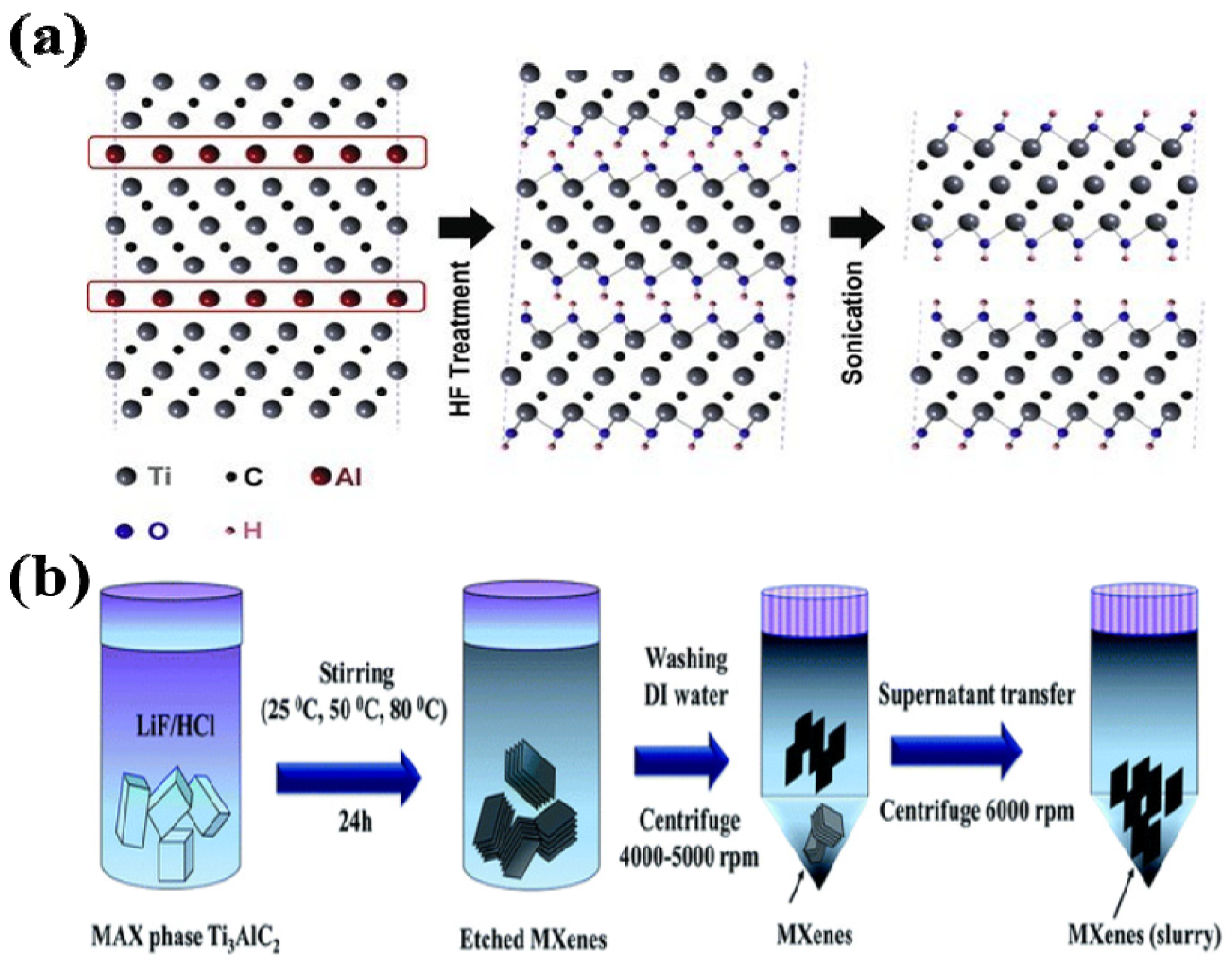
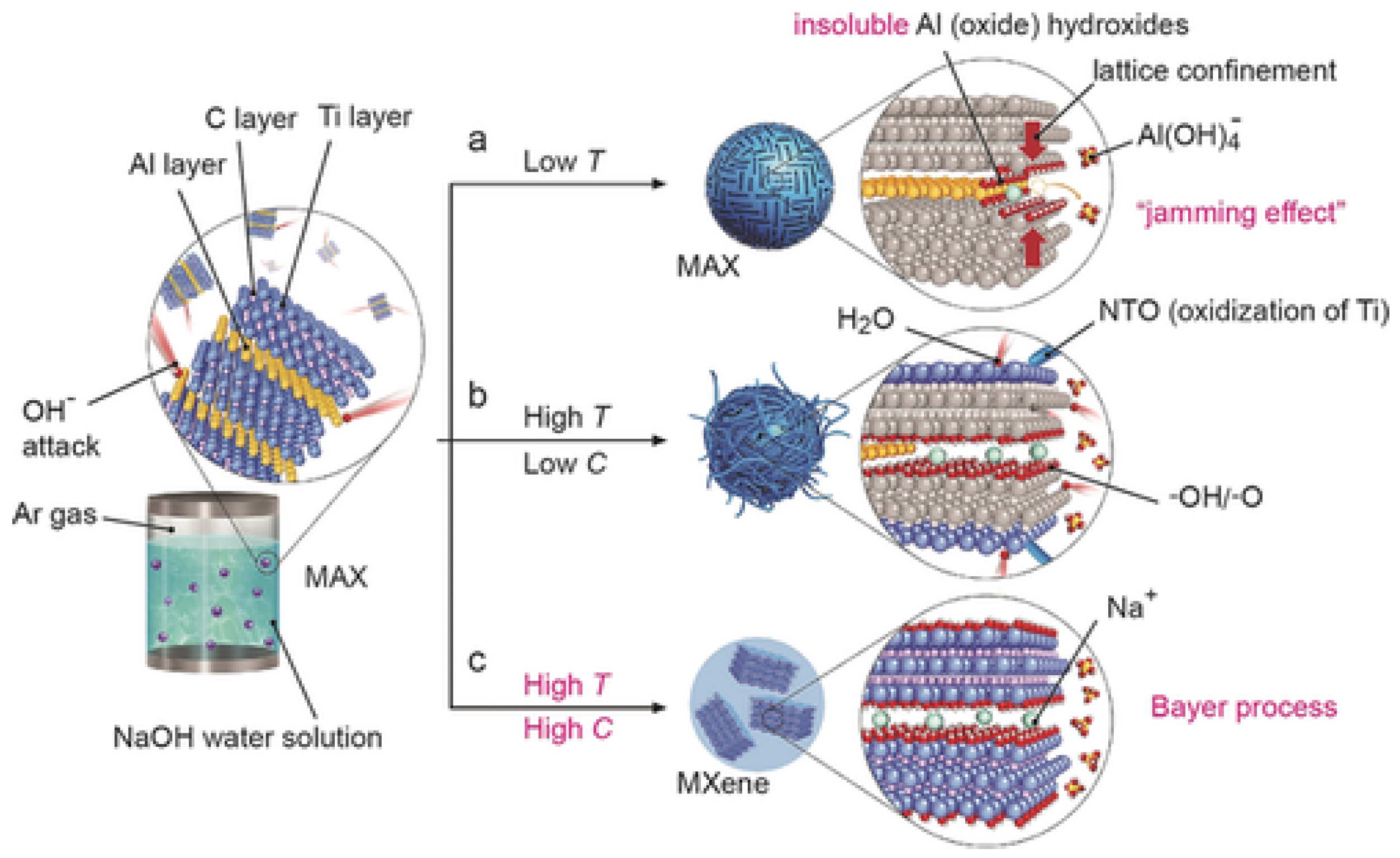
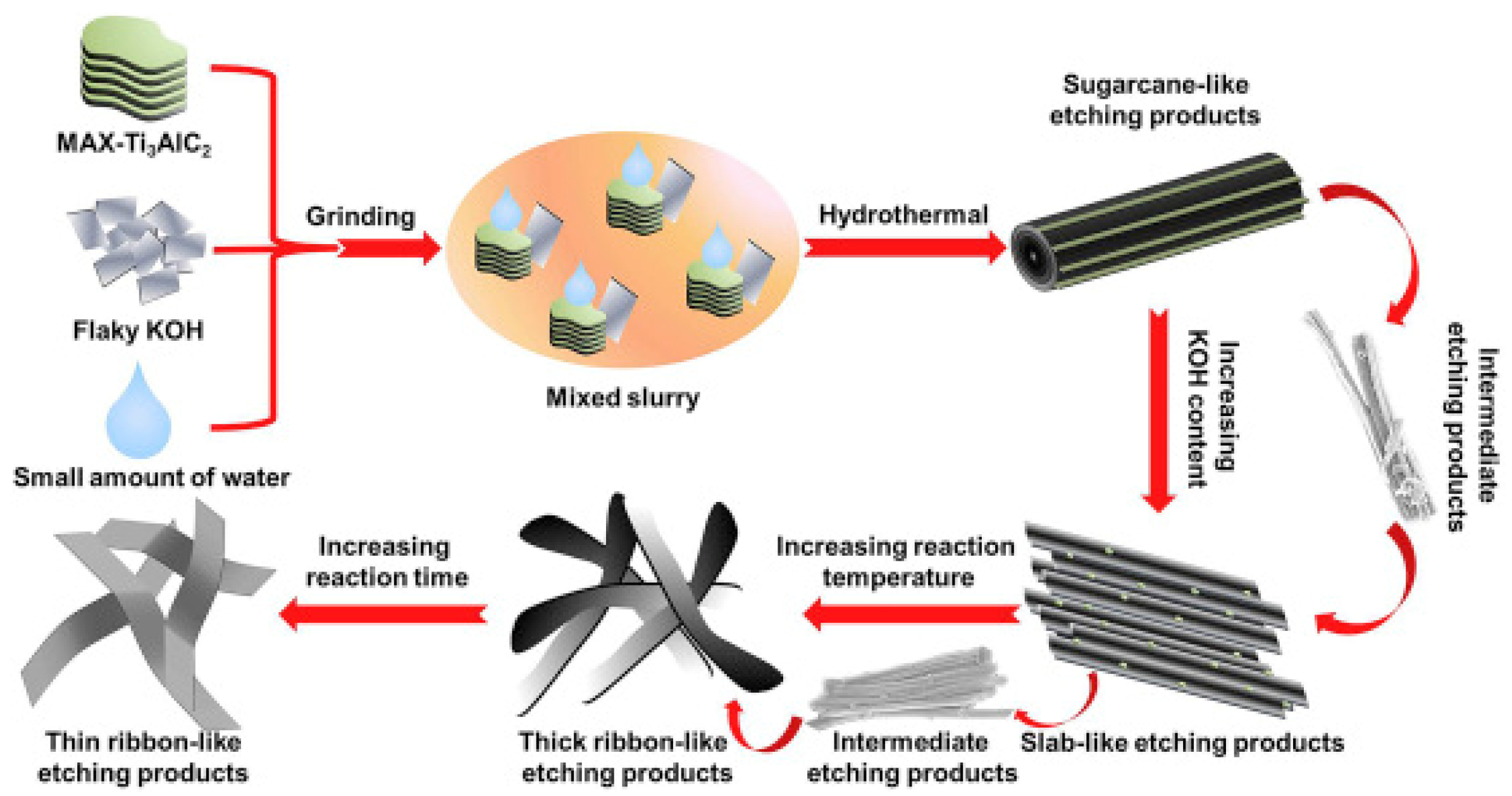


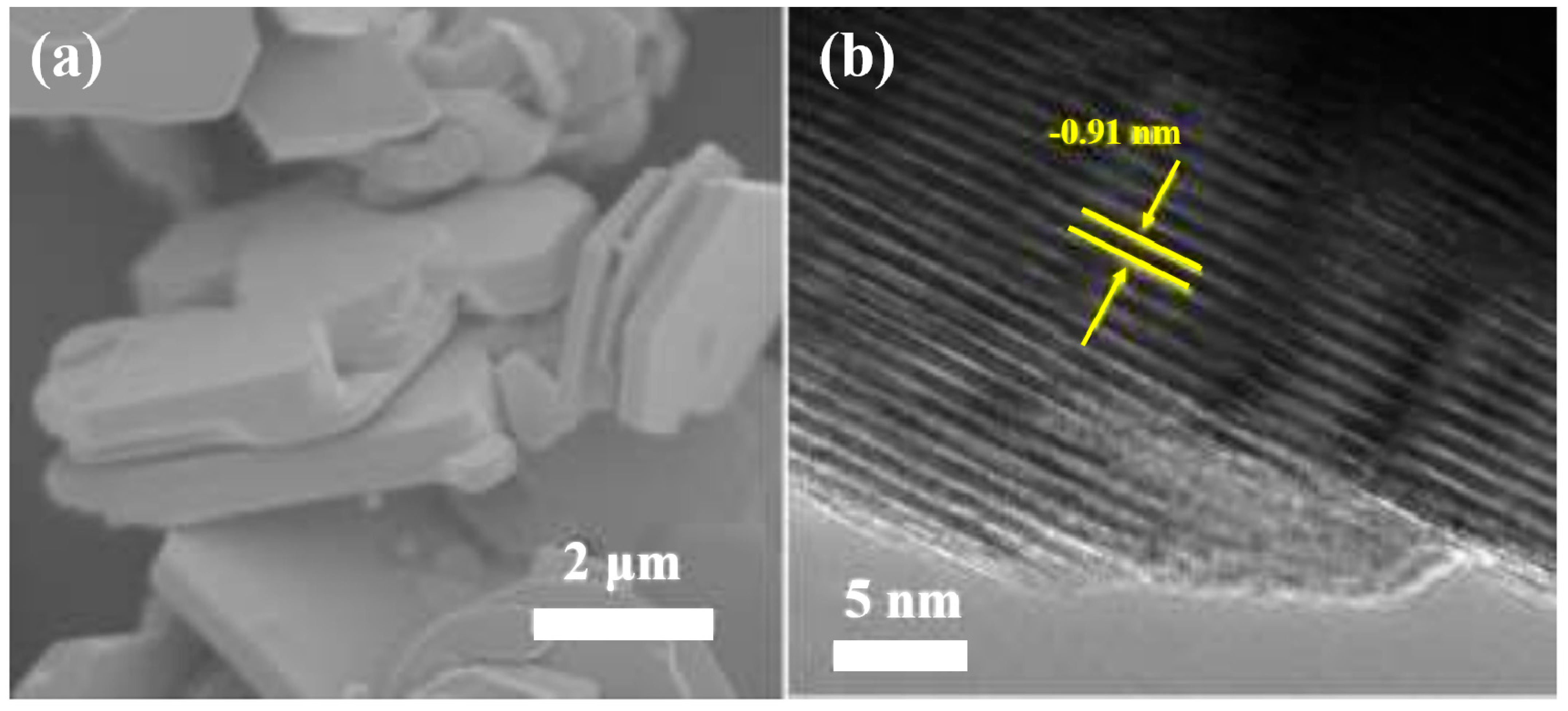
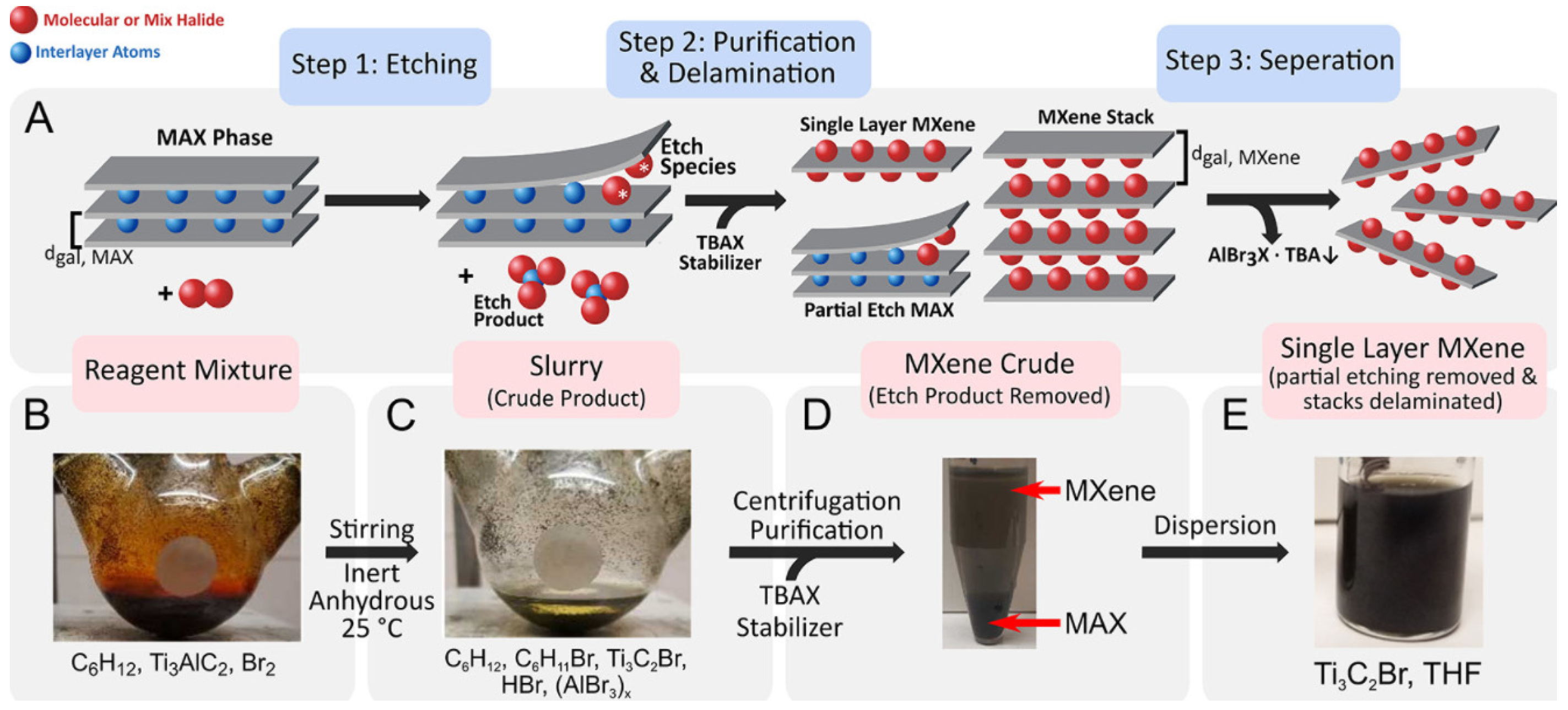
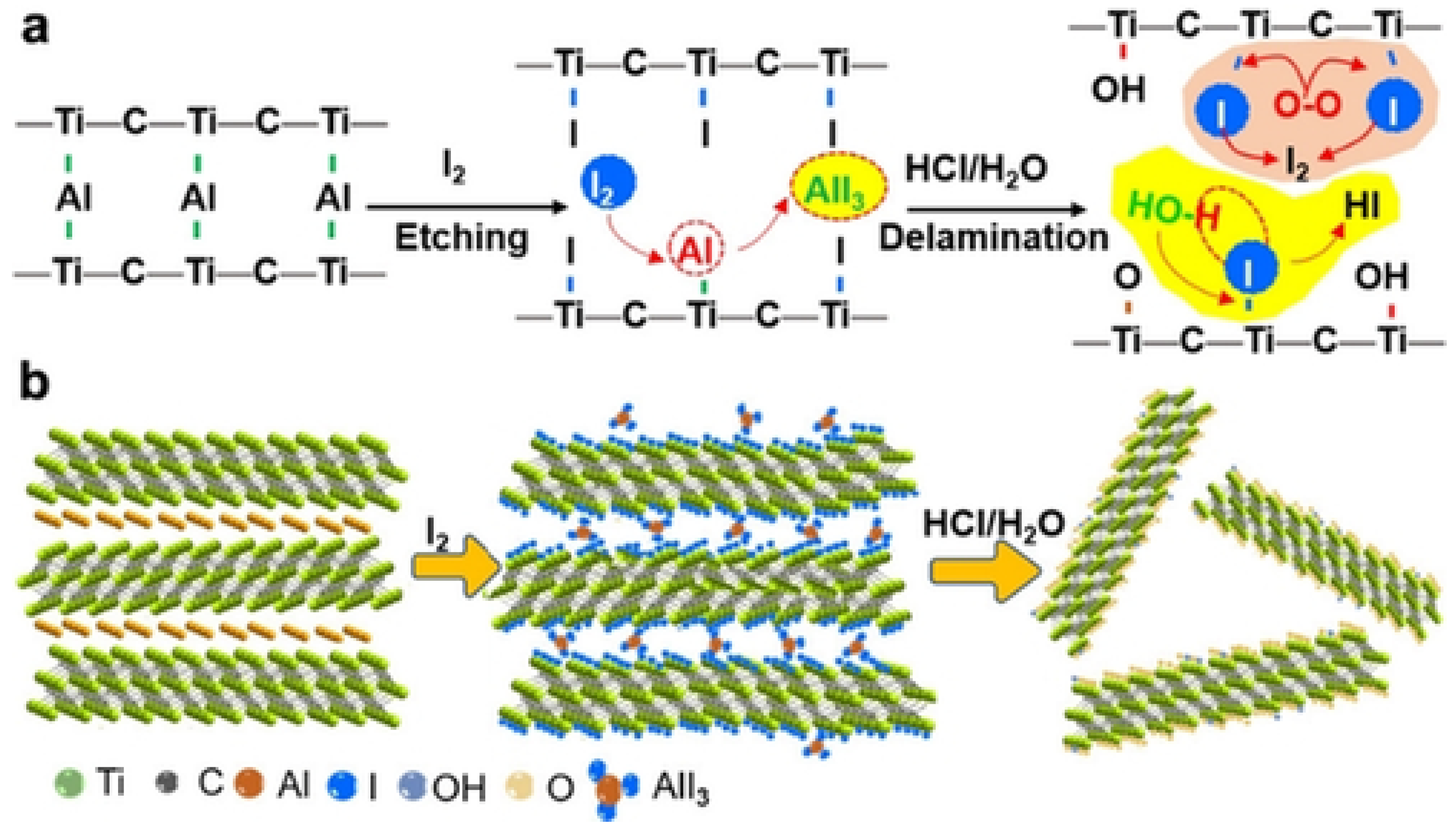
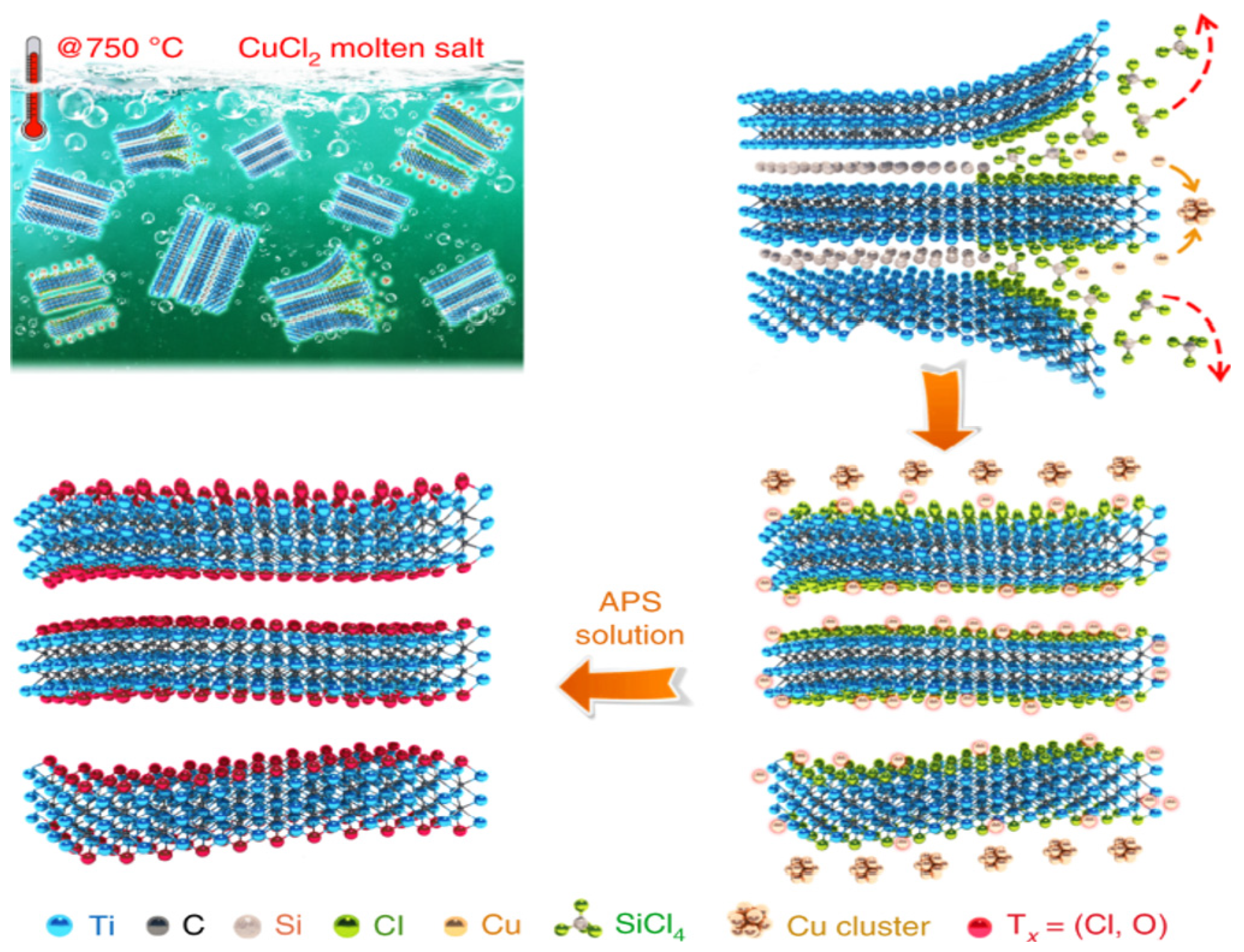


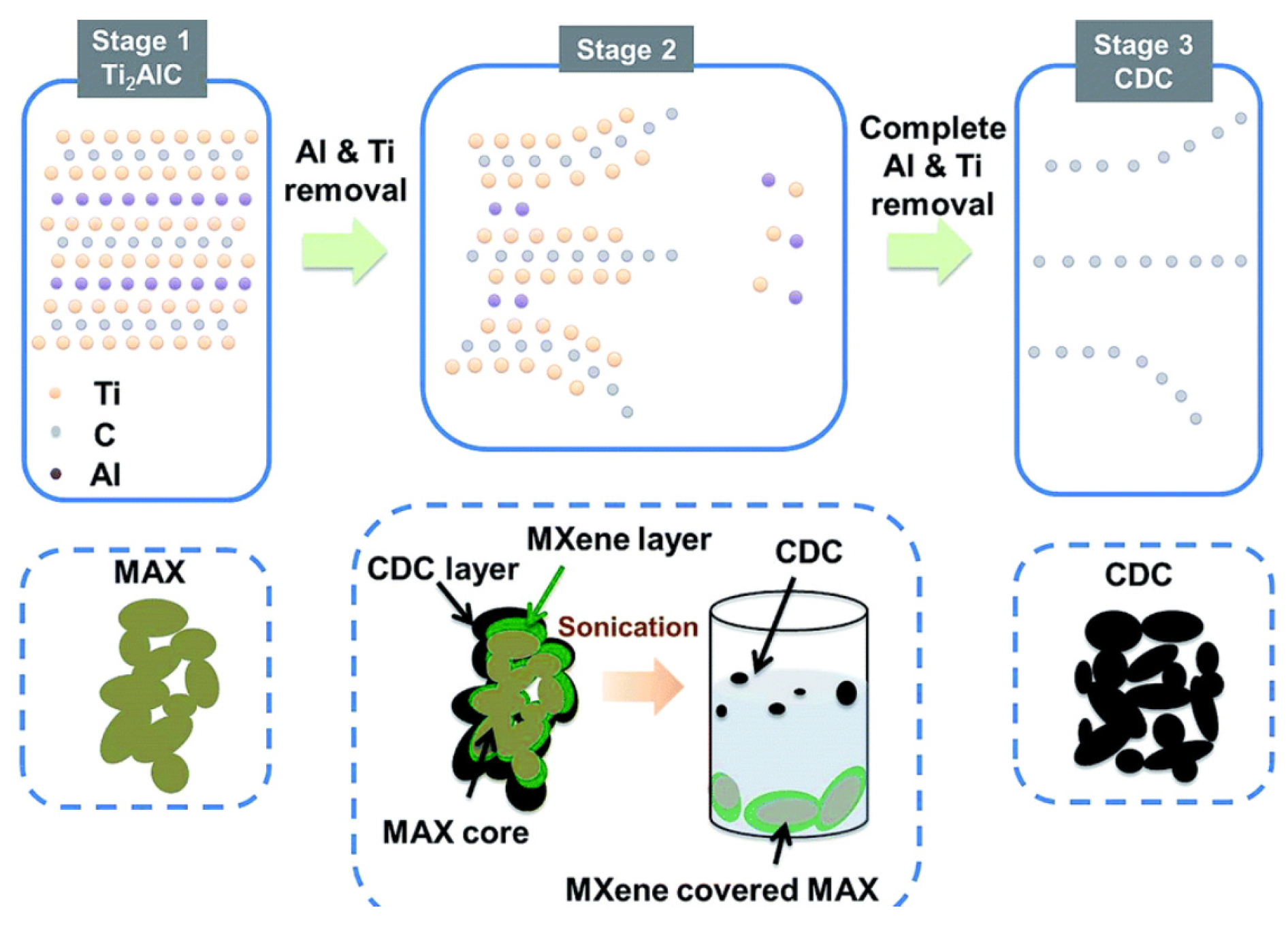
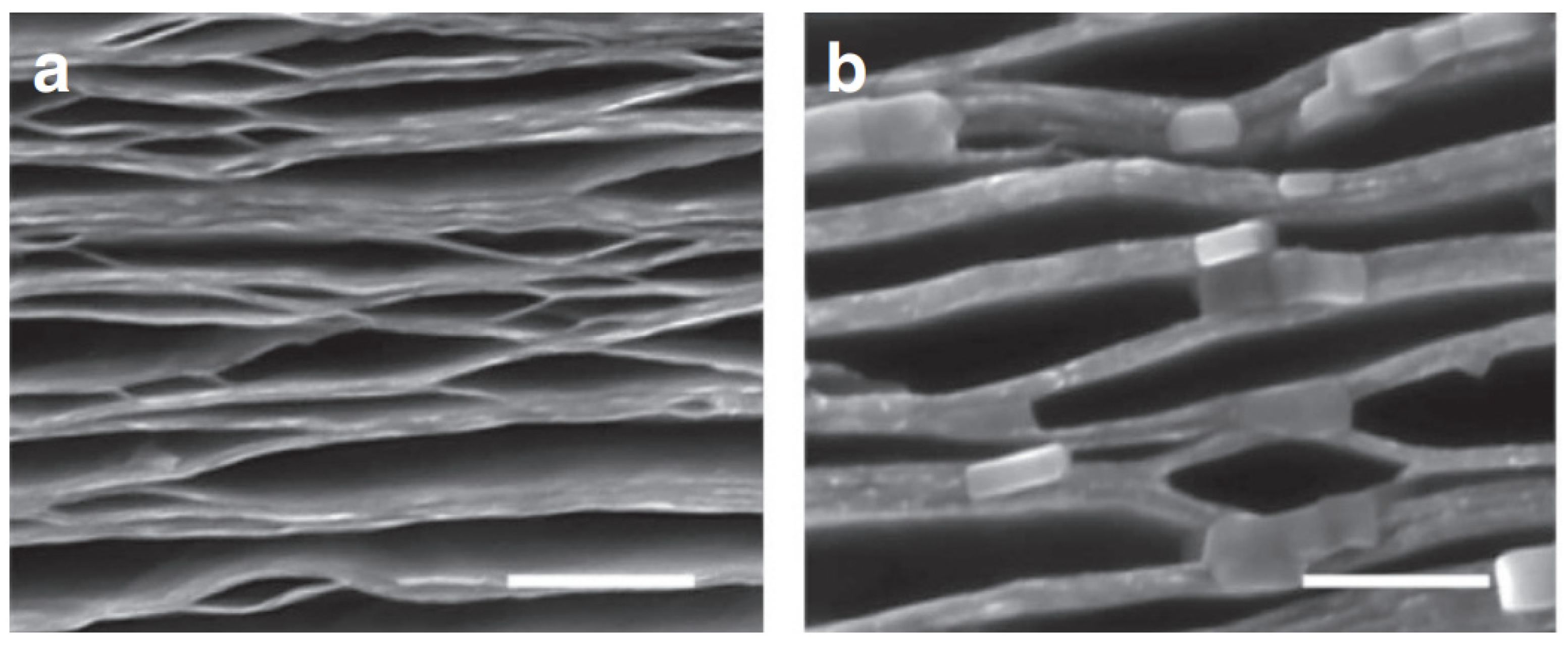
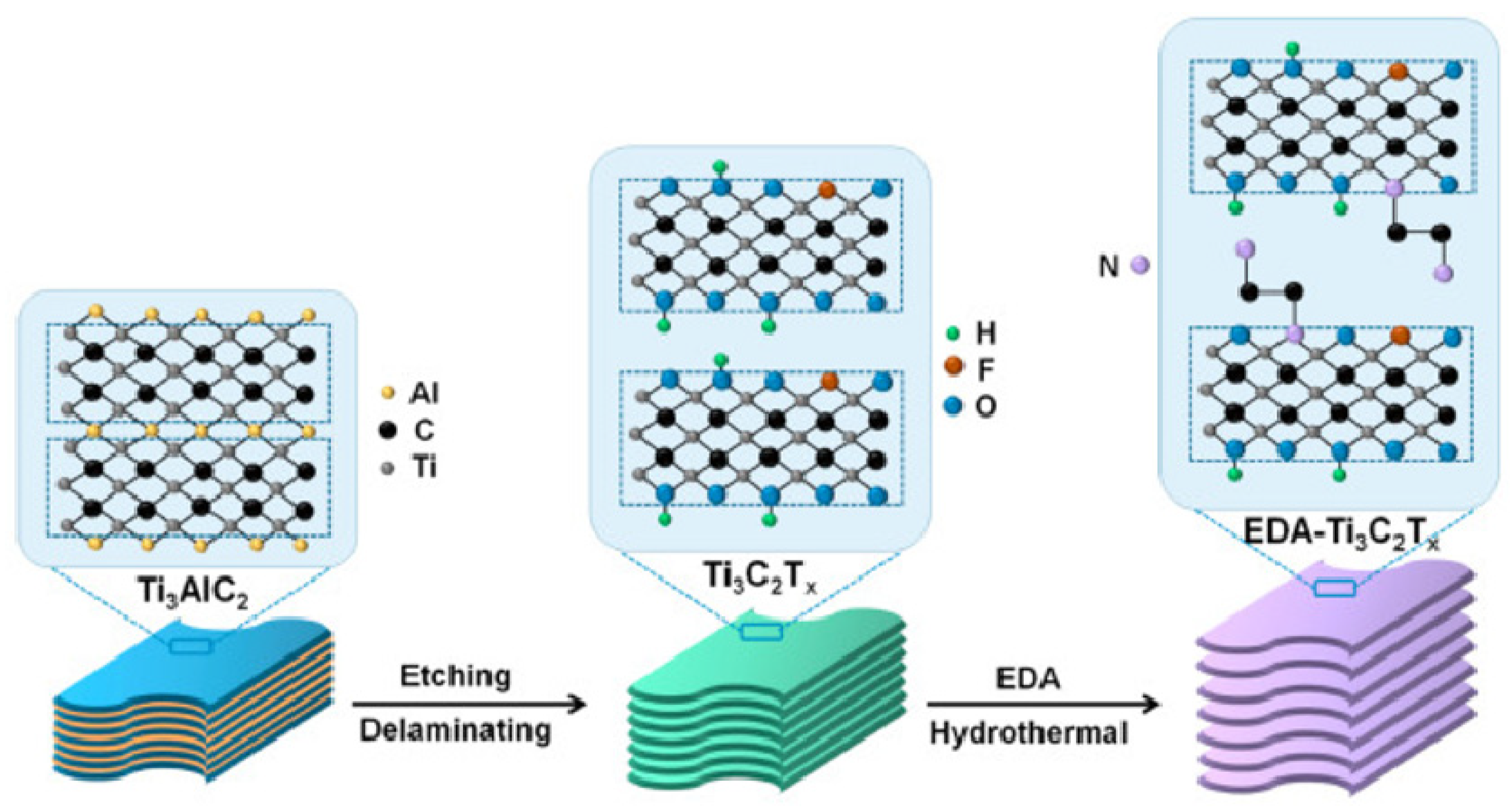

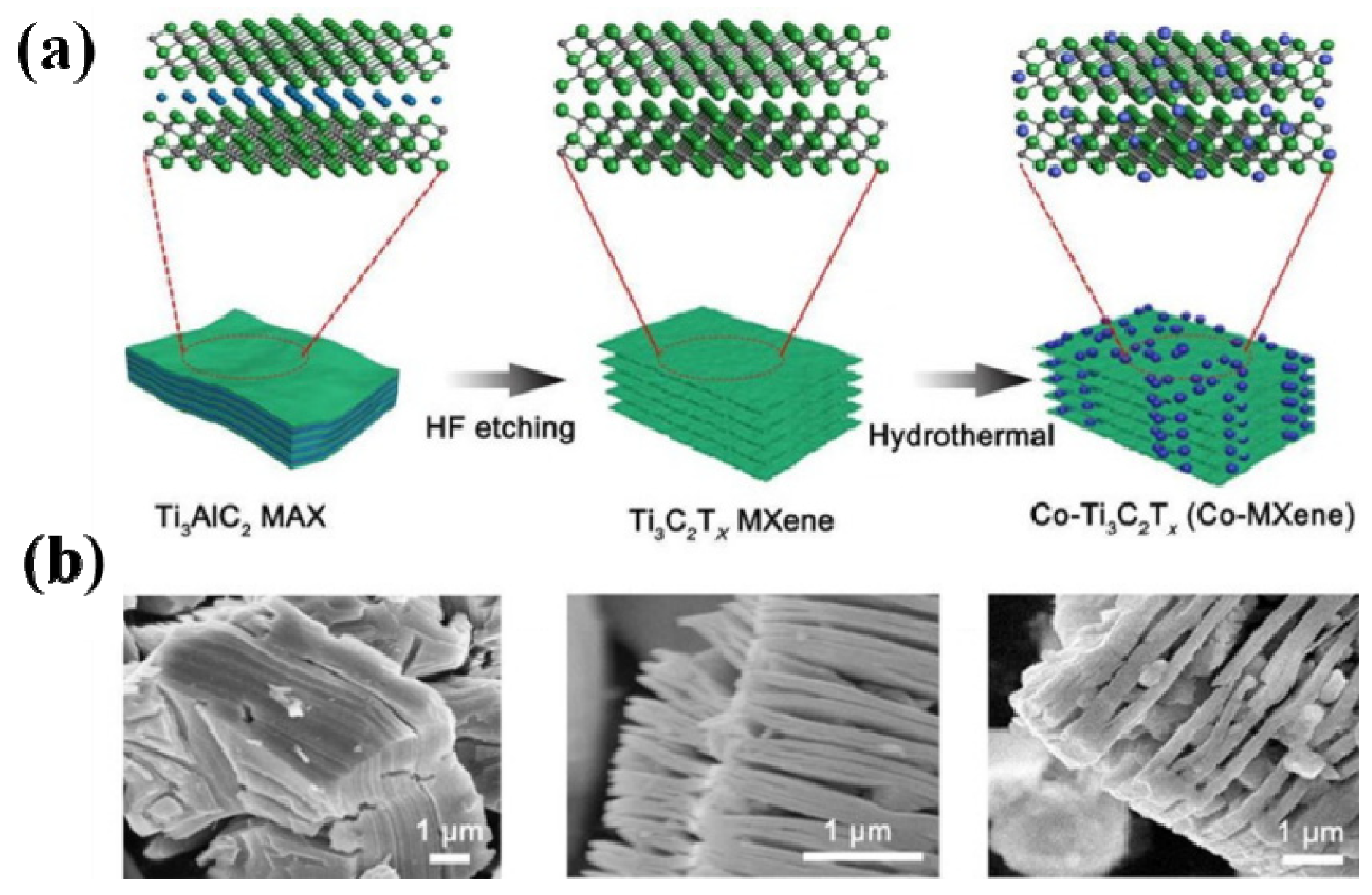

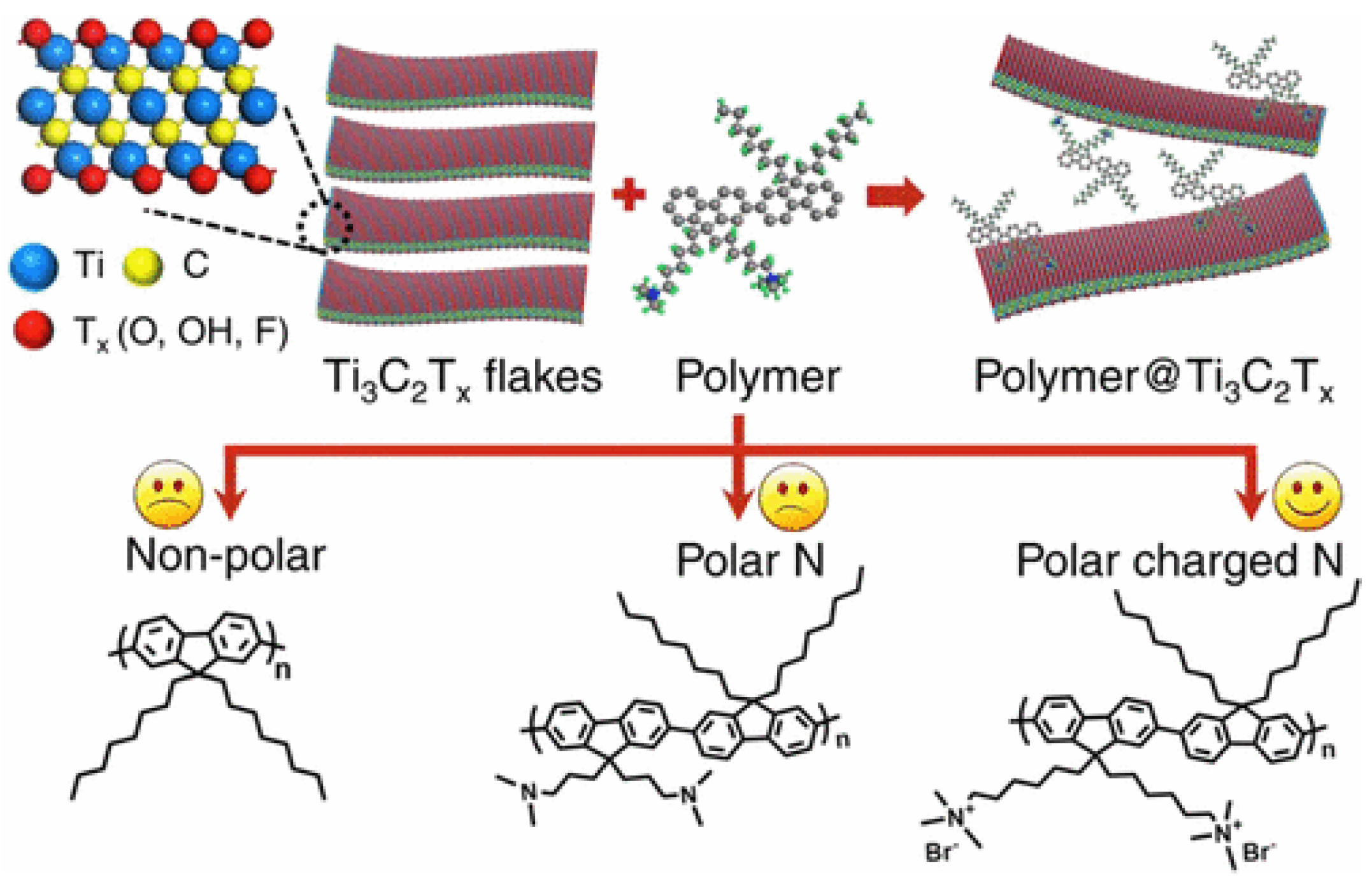
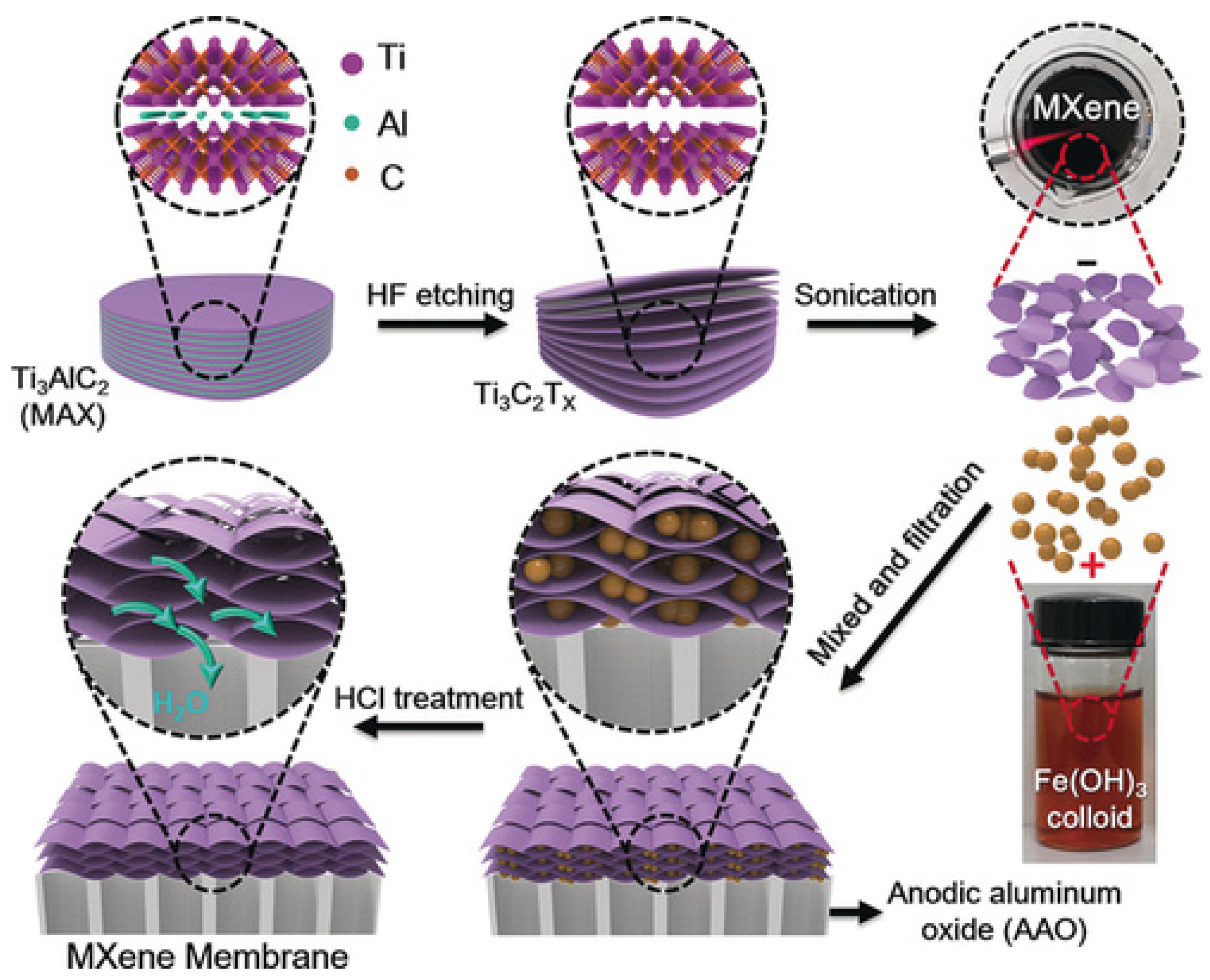

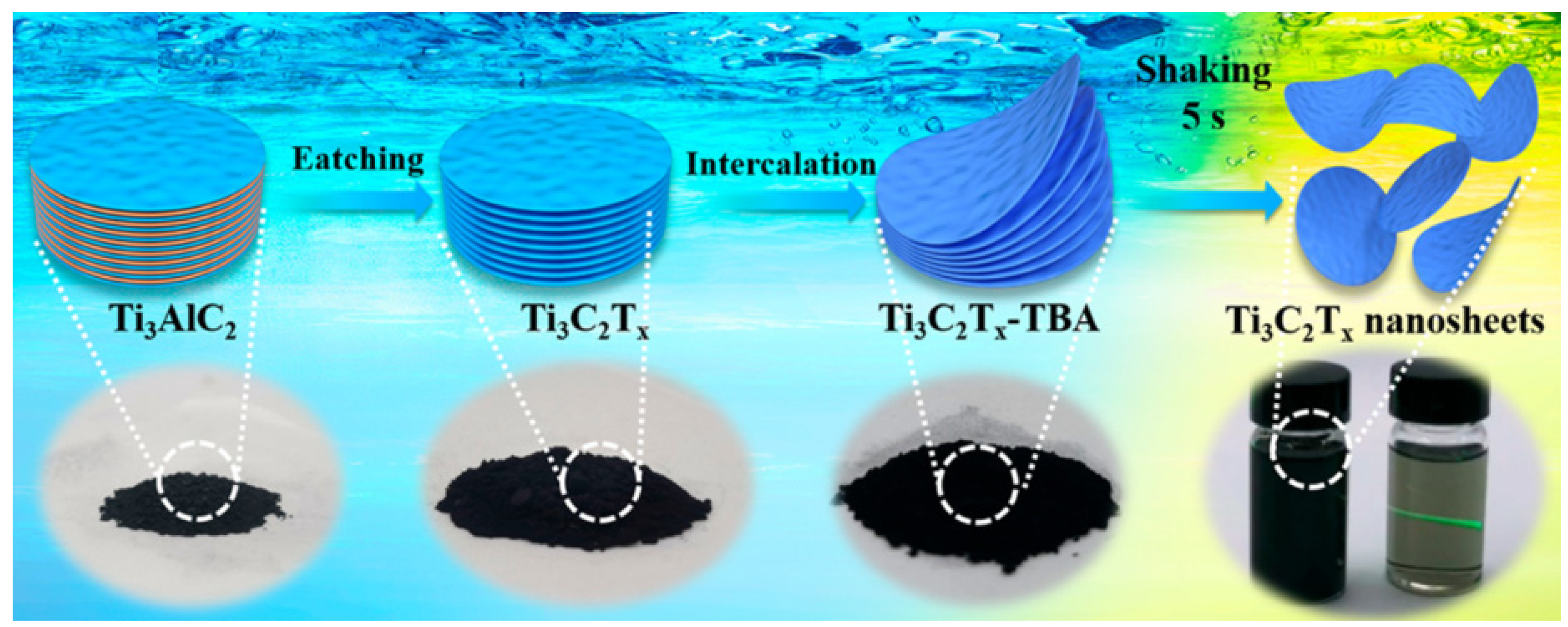
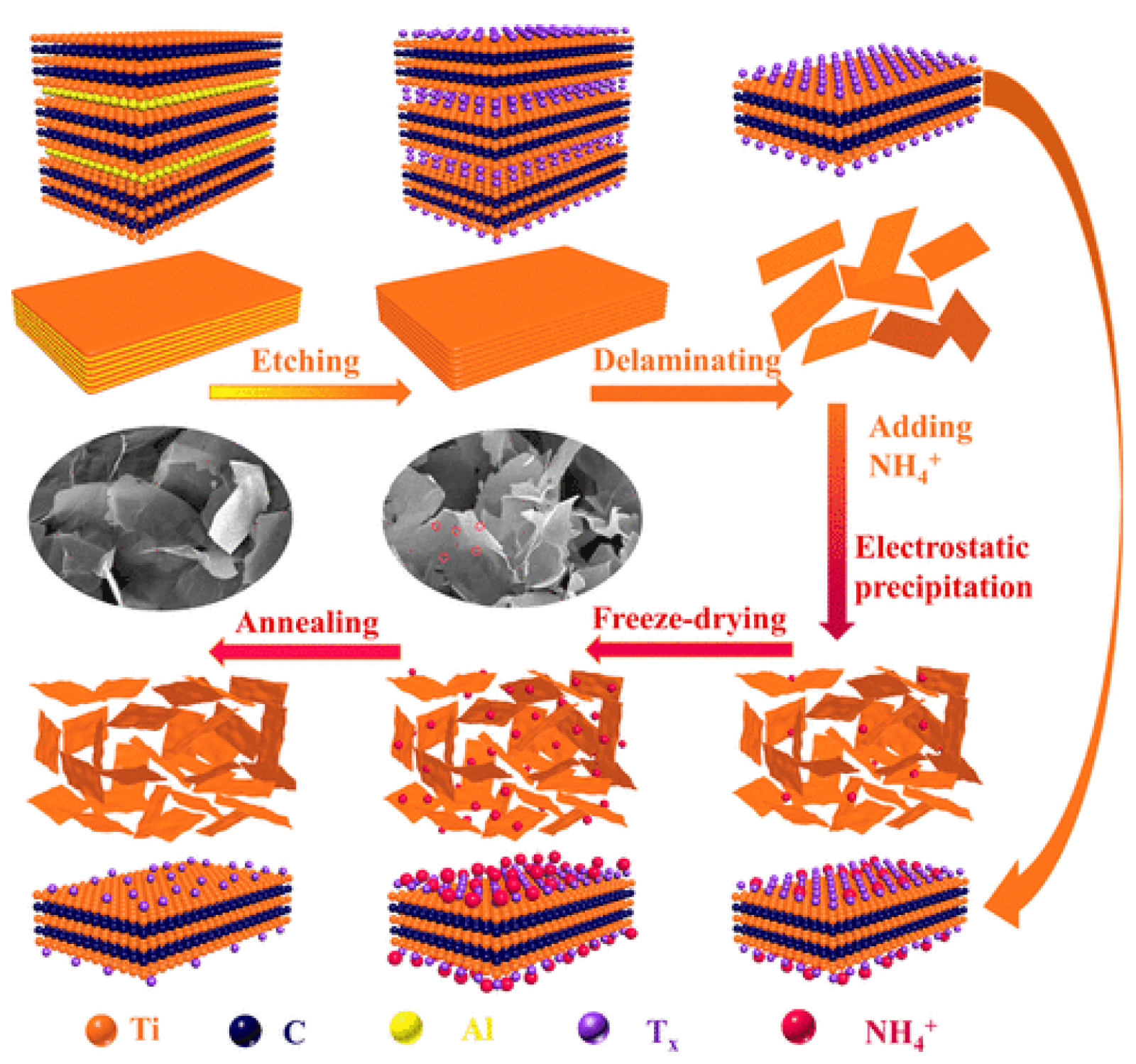


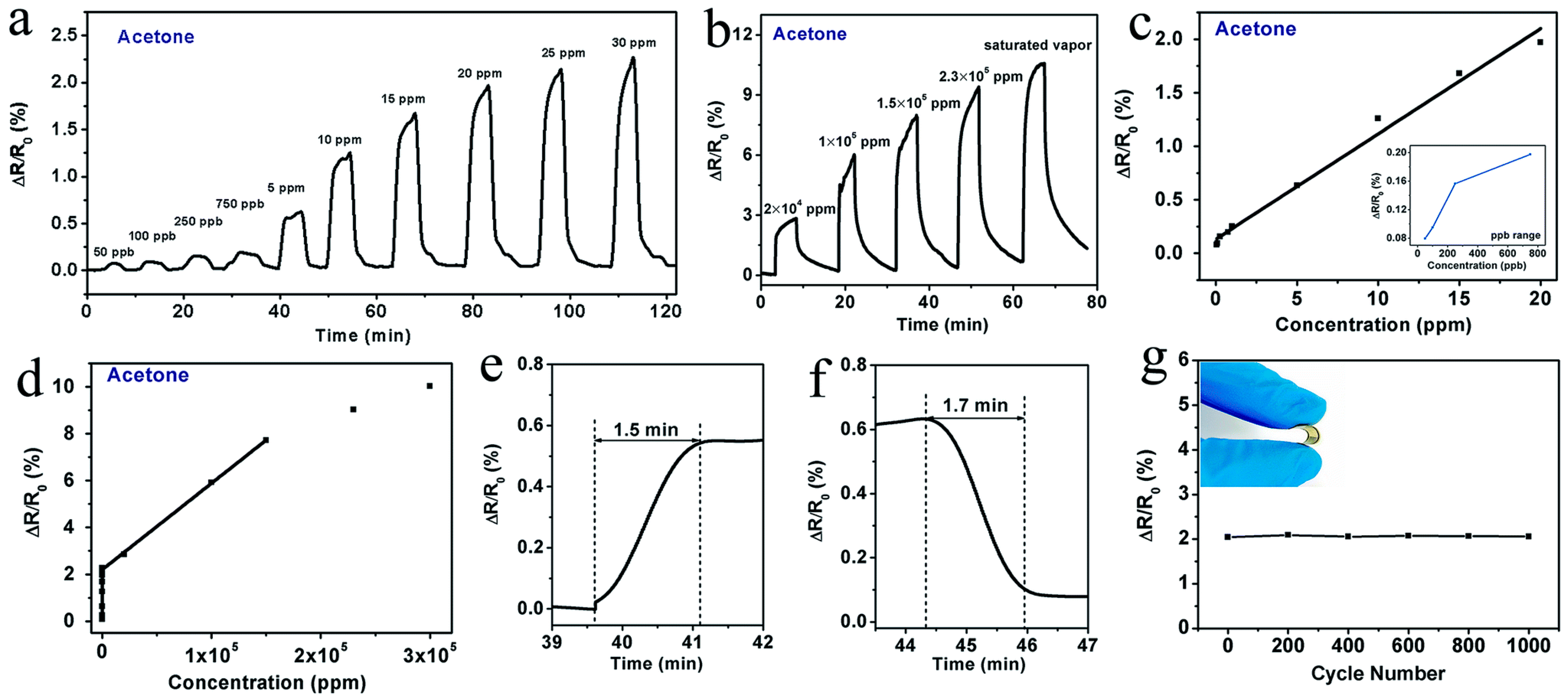
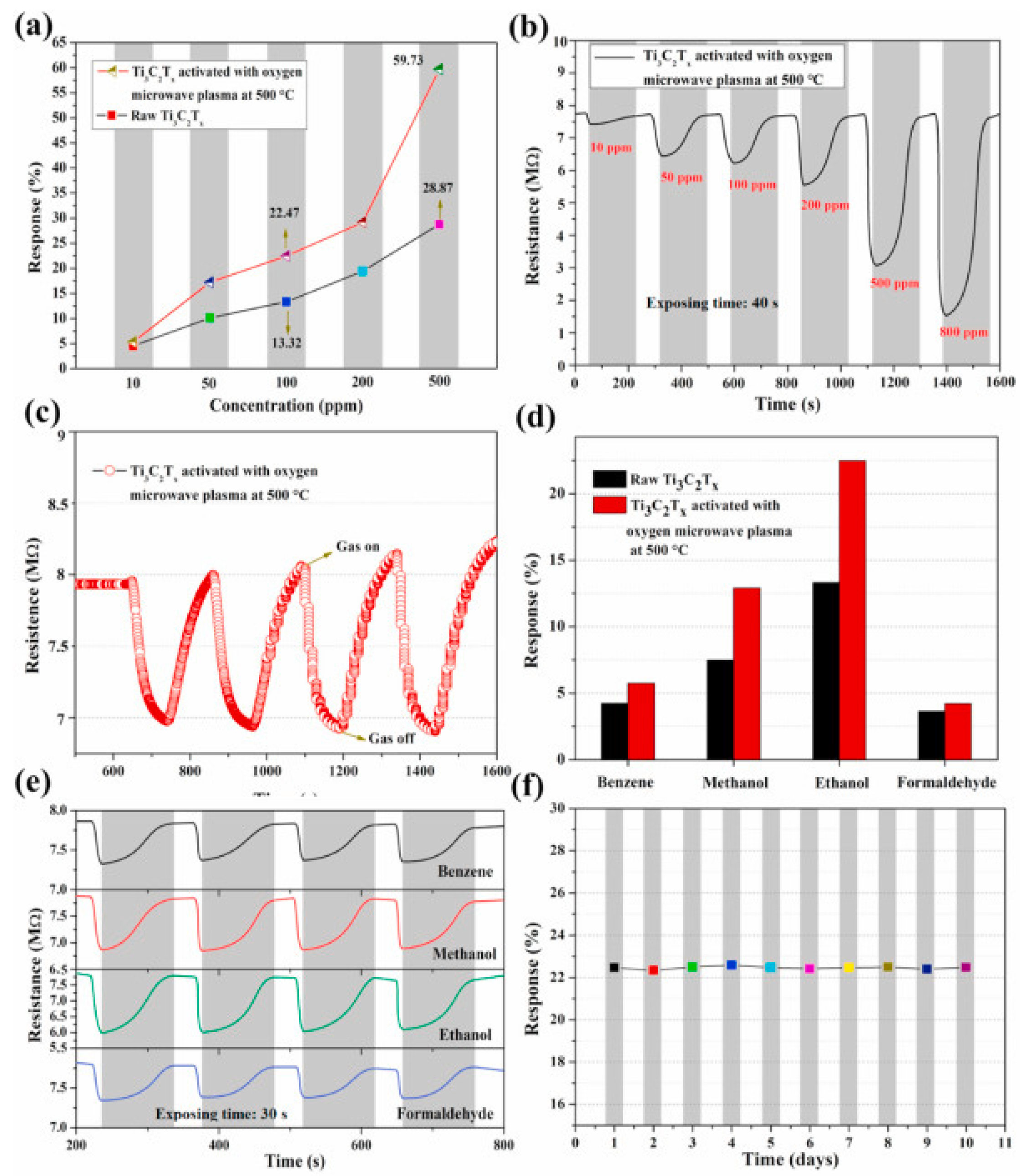




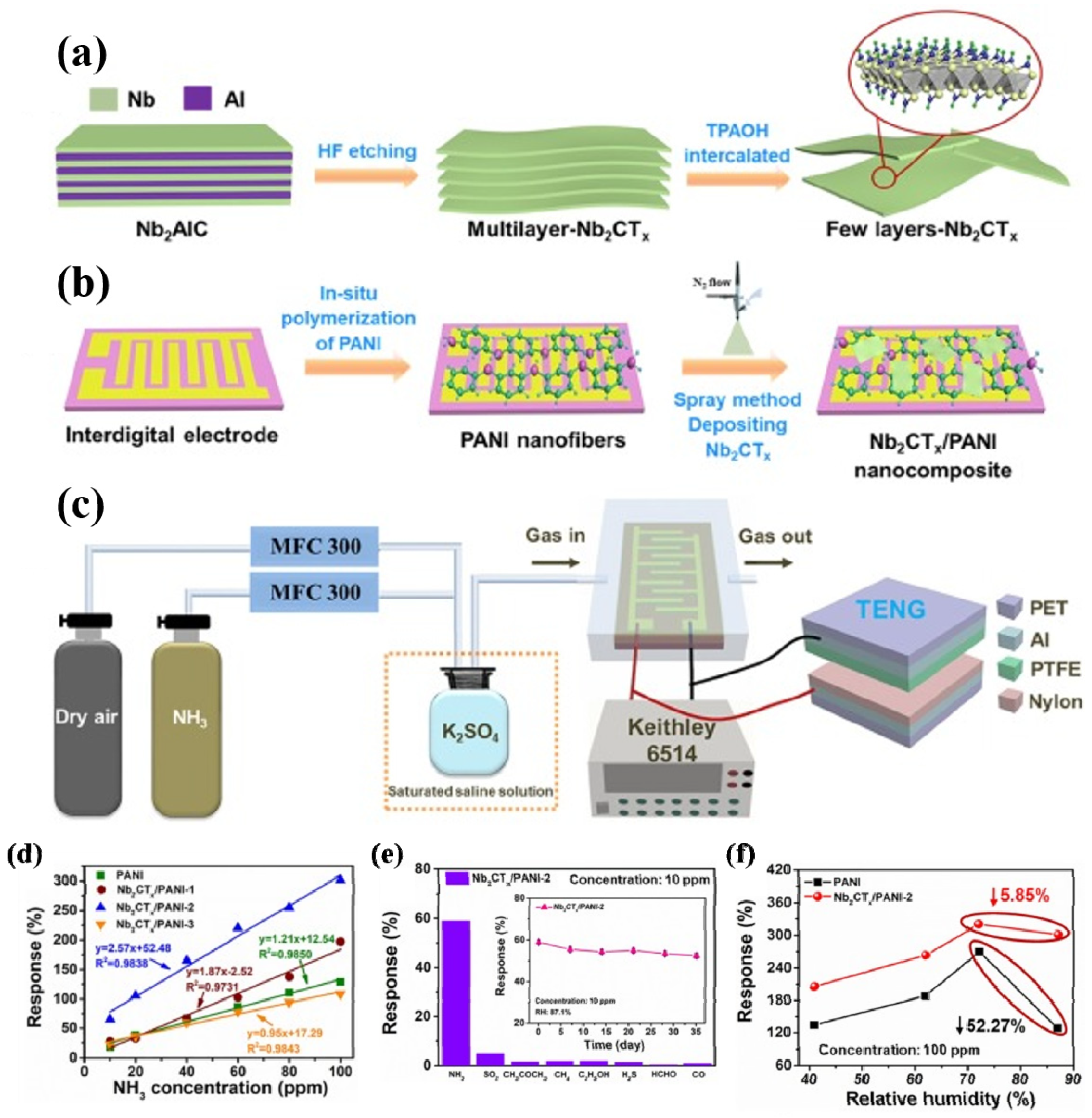
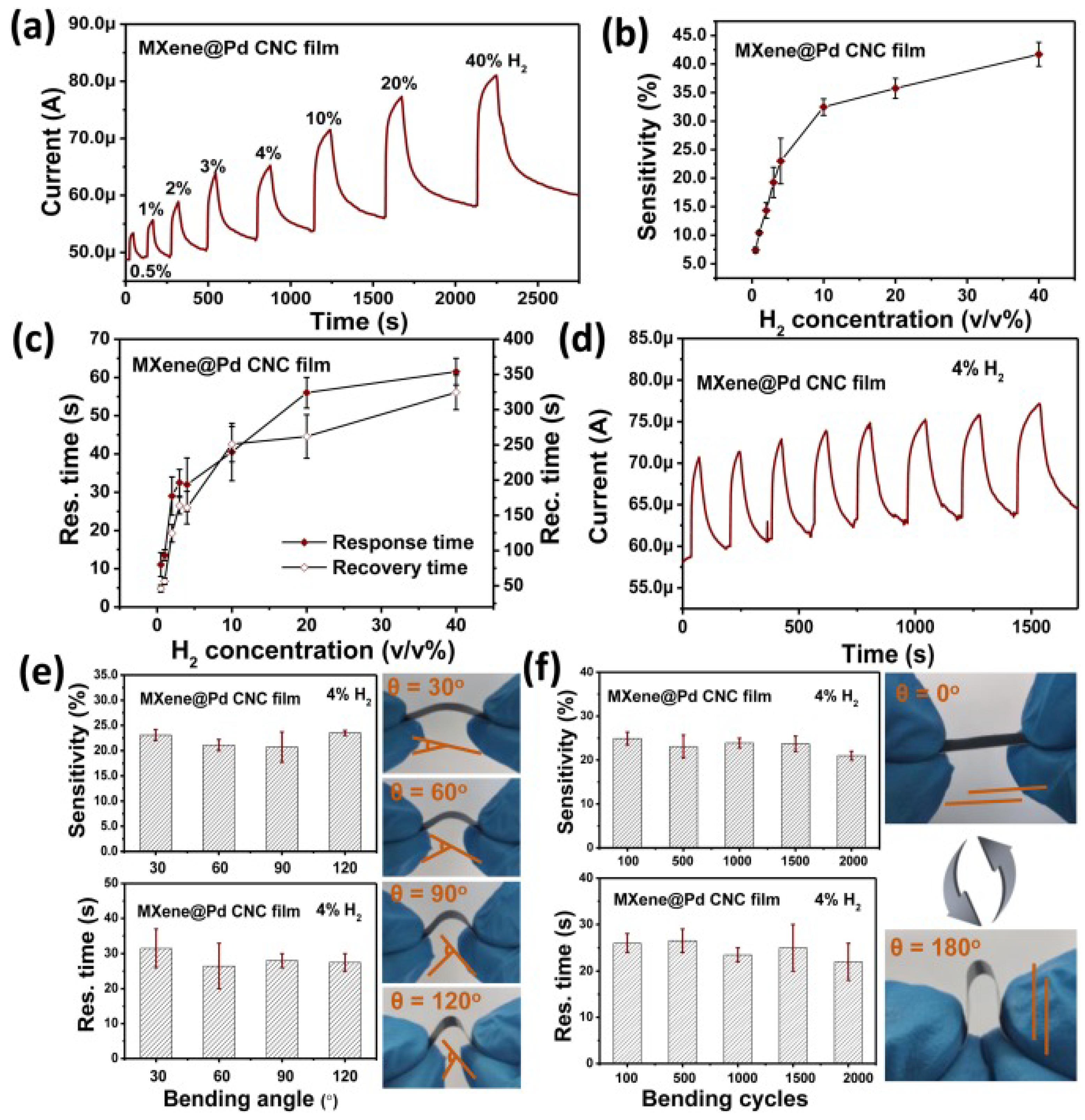
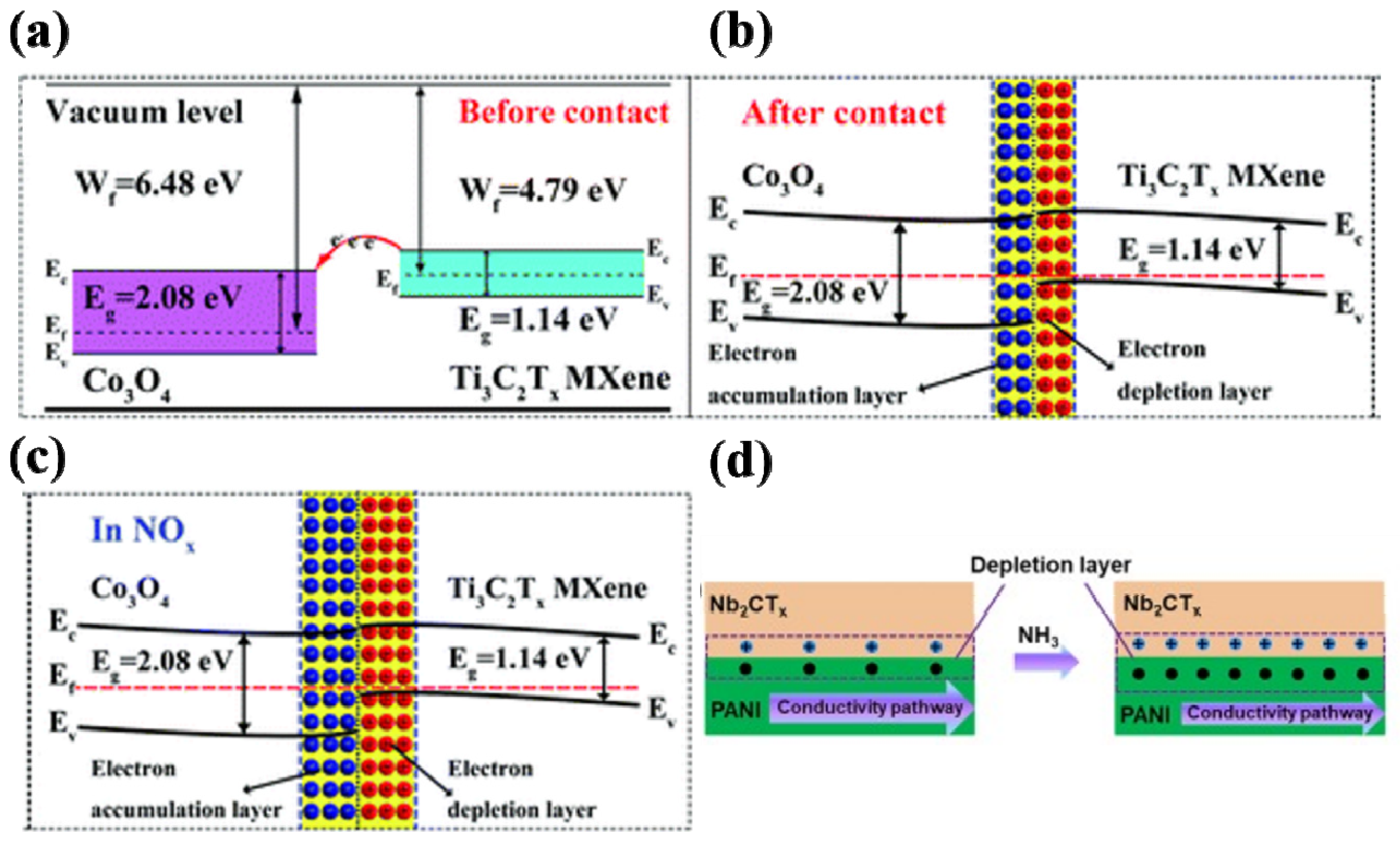
| Material | Gas | Conc. (ppm) | Operating Temp (°C) | Response % | Response/Recovery Time (s/s) | References |
|---|---|---|---|---|---|---|
| Ti3C2Tx | Acetone | 5 | RT | 3.6 | 90/102 | [130] |
| Ethanol | 100 | RT | 22.47 | -/- | [131] | |
| Mo2CTx | Toluene | 100 | RT | 2.65 | -/- | [132] |
| Ti3C2Tx/CuO | Toluene | 50 | 250 | 11.4 | 270/10 | [49] |
| Ti3C2Tx/ZnO | NO2 | 100 | RT | 41.93 | 34/105 | [133] |
| Ti3C2Tx/SnO2 | NH3 | 50 | RT | 40 | 36/44 | [129] |
| Ti3C2Tx/SnO-SnO2 | Acetone | 100 | RT | 12.1 | 18/9 | [134] |
| Ti3C2Tx/Co3O4 | HCHO | 10 | RT | 9.2 | 83/5 | [135] |
| Ti3C2Tx/WO3 | NH3 | 1 | RT | 22.3 | 119/228 | [128] |
| Ti3C2Tx/W18O49 | Acetone | 0.17 | 300 | 1.4 | 5.6/6 | [136] |
| Ti3C2Tx/In2O3 | Methane | 5 | RT | 29.6 | 6.5/3.5 | [137] |
| Ti3C2Tx/PANI | Ethanol | 200 | RT | 41.1 | 0.4/0.5 | [138] |
| NH3 | 50 | RT | 400 | -/- | [139] | |
| Nb2CTx/PANI | NH3 | 100 | RT | 301.31 | 105/143 | [140] |
| Ti3C2Tx/PEDOT:PSS | NH3 | 100 | RT | 36.6 | 116/40 | [141] |
| V2CTx | H2 | 2 | RT | - | 120/420 | [85] |
| Methane | 25 | RT | - | 480/330 | ||
| Pd-Ti3C2Tx | H2 | 4000 | RT | 23 | 37/161 | [142] |
| 100 | RT | 56 | -/- | [143] | ||
| SnS2/Ti3C2Tx | NO2 | 1000 | RT | 115 | 64/10 | [144] |
| Ti3C2Tx/WSe2 | Ethanol | 40 | RT | 24 | 9.7/6.6 | [145] |
| S-Ti3C2Tx | Toluene | 10 | RT | 59.1 | -/- | [146] |
| Ti3C2Tx | Ethanol | 120 | RT | 14 | 39/139 | [147] |
| Ti3C2Tx/Fe2(MoO4)3 | N-butane | 100 | RT | 43.1 | 18/24 | [148] |
| Ti3C2Tx | NH3 | 100 | RT | 28.87 | 1/201 | [149] |
| Ti3C2Tx/GO | NH3 | 100 | RT | 7.21 | -/- | [150] |
| rGO/N-Ti3C2Tx/TiO2 | HCHO | 20 | RT | 132 | -/- | [151] |
| Co3O4@PEI/Ti3C2Tx | NOx | 100 | RT | 27.9 | 1.6/73.1 | [152] |
| Ti3C2Tx/rGO/CuO | Acetone | 100 | RT | 52.09 | 6.5/7.5 | [127] |
Publisher’s Note: MDPI stays neutral with regard to jurisdictional claims in published maps and institutional affiliations. |
© 2021 by the authors. Licensee MDPI, Basel, Switzerland. This article is an open access article distributed under the terms and conditions of the Creative Commons Attribution (CC BY) license (https://creativecommons.org/licenses/by/4.0/).
Share and Cite
Li, Q.; Li, Y.; Zeng, W. Preparation and Application of 2D MXene-Based Gas Sensors: A Review. Chemosensors 2021, 9, 225. https://doi.org/10.3390/chemosensors9080225
Li Q, Li Y, Zeng W. Preparation and Application of 2D MXene-Based Gas Sensors: A Review. Chemosensors. 2021; 9(8):225. https://doi.org/10.3390/chemosensors9080225
Chicago/Turabian StyleLi, Qingting, Yanqiong Li, and Wen Zeng. 2021. "Preparation and Application of 2D MXene-Based Gas Sensors: A Review" Chemosensors 9, no. 8: 225. https://doi.org/10.3390/chemosensors9080225
APA StyleLi, Q., Li, Y., & Zeng, W. (2021). Preparation and Application of 2D MXene-Based Gas Sensors: A Review. Chemosensors, 9(8), 225. https://doi.org/10.3390/chemosensors9080225





